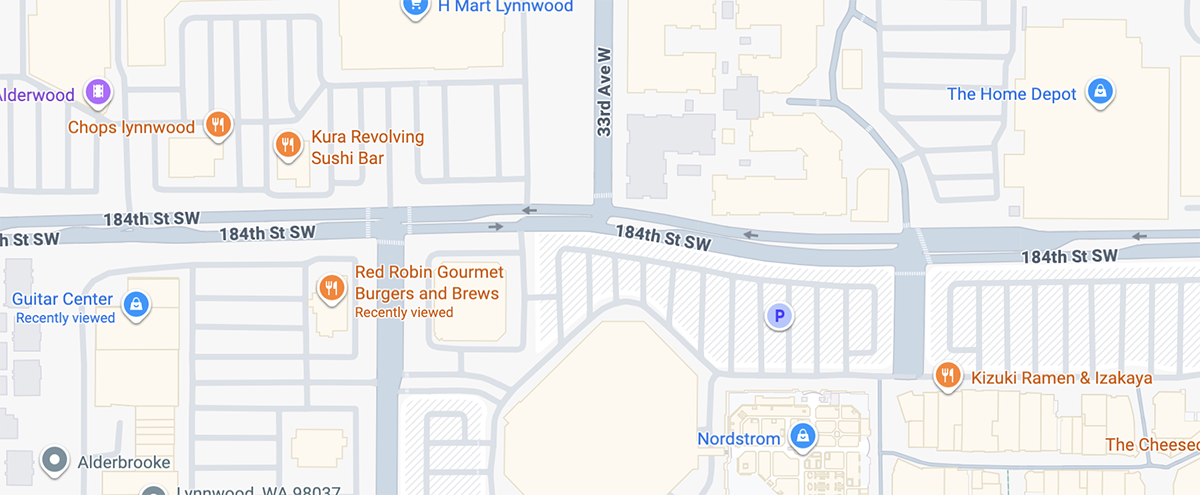Buildings on the Sno-King Upland Plain that existed in the years 1975–2000
Theaters
Alderwood Stadium 7
Opened by Luxury Theaters in 1986. Acquired by Regal in 1998 and remodeled in 2004. Regal introduced RPX in 2010.
 |
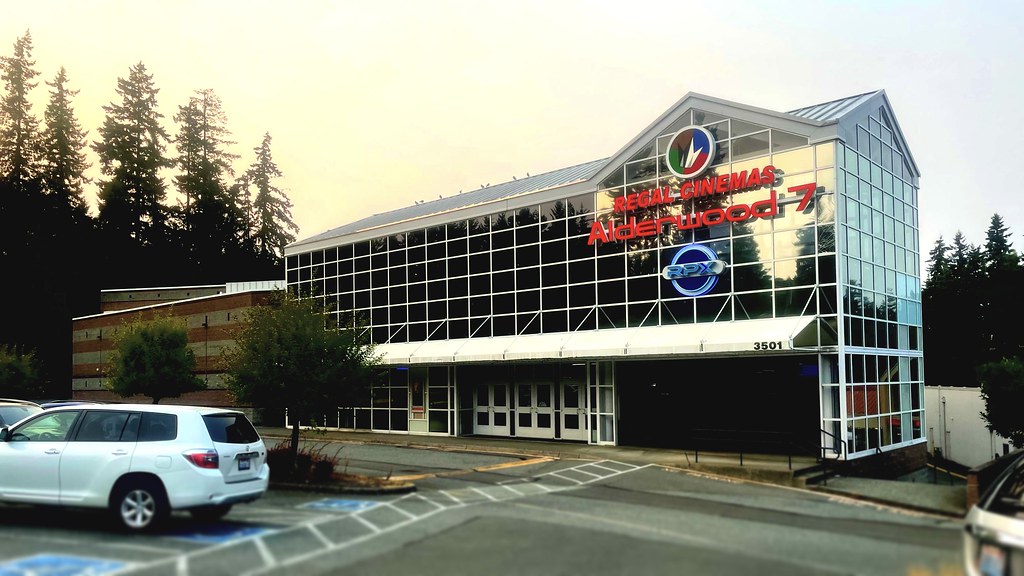 |
Alderwood Village Cinema 12
A supermarket that was converted to dollar cinemas in 1987. The cinemas closed in 2001.
As of 2025 the building is still there, though there are plans to replace it with a parking garage for the expanded Lynnwood Event Center. 194th St SW will be created to the north of the complex.
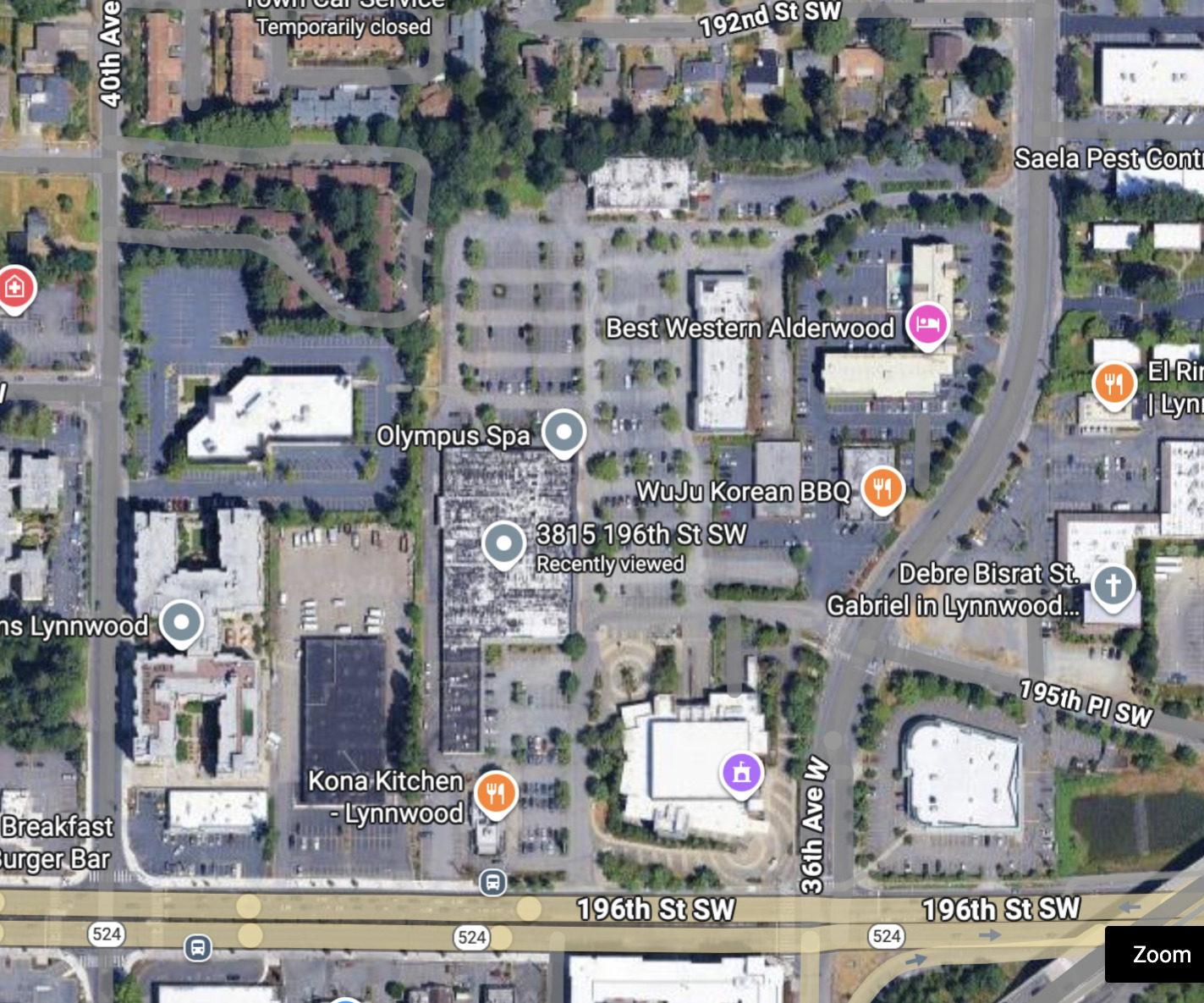 |
 |
- "Lynnwood Council greenlights a new $600 million vision for the Lynnwood Event Center", lynnwoodtimes.com, 14 Oct 2025
- Alderwood Village Cinema 12, cinematreasures.org
Aurora Village 4
4 screens opened at Aurora Village in 1980. Closed in 1993.
Crest Cinema Center
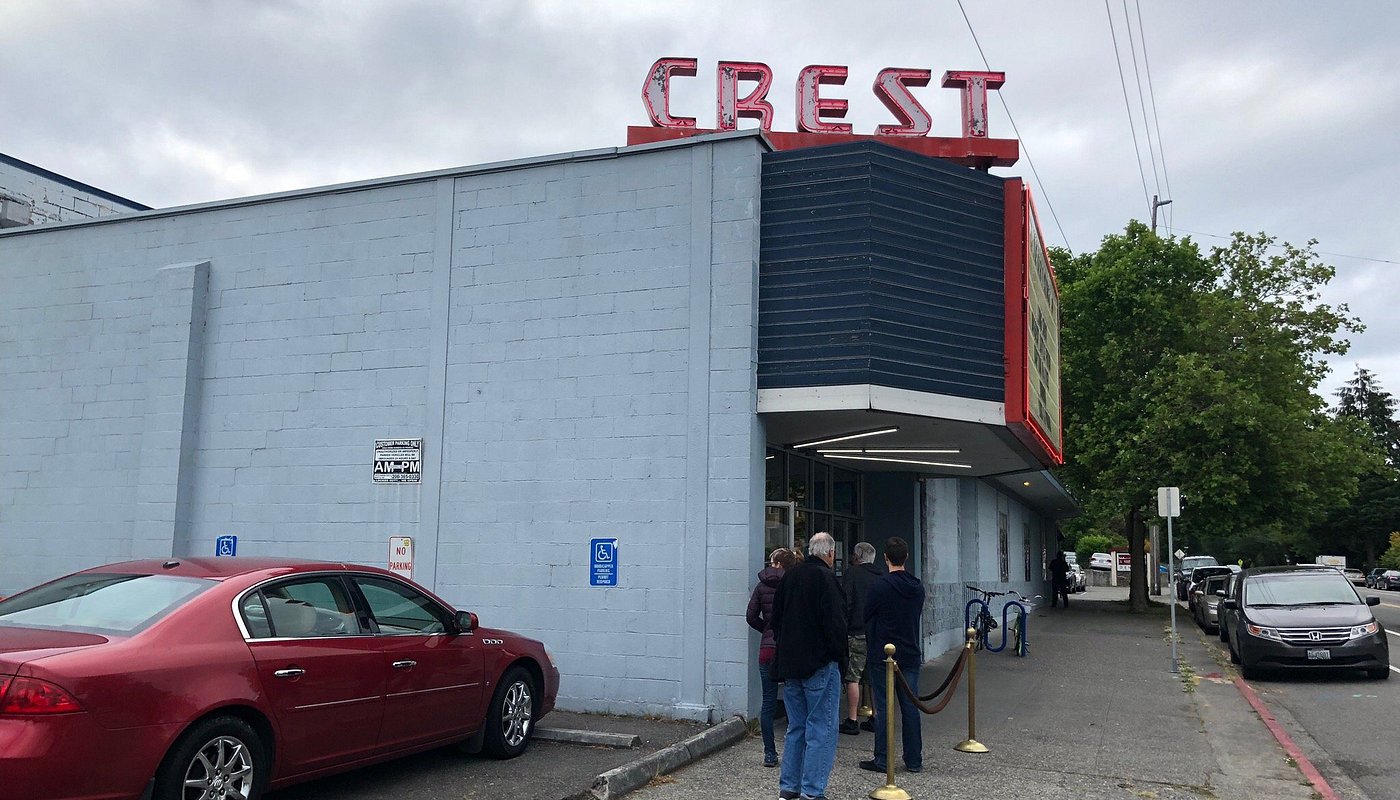 |
Built as a single screen theater in 1949. Acquired by Randy Finley's Seven Gables Theaters. An extra screen was added in 1979 by taking over the adjacent storefronts. In 1980 the main auditorium was split in three, giving the complex 4 screens. Landmark acquired the property in 1989. I watched "Pulp Fiction" at the Crest in 1994.
Edmonds Theater
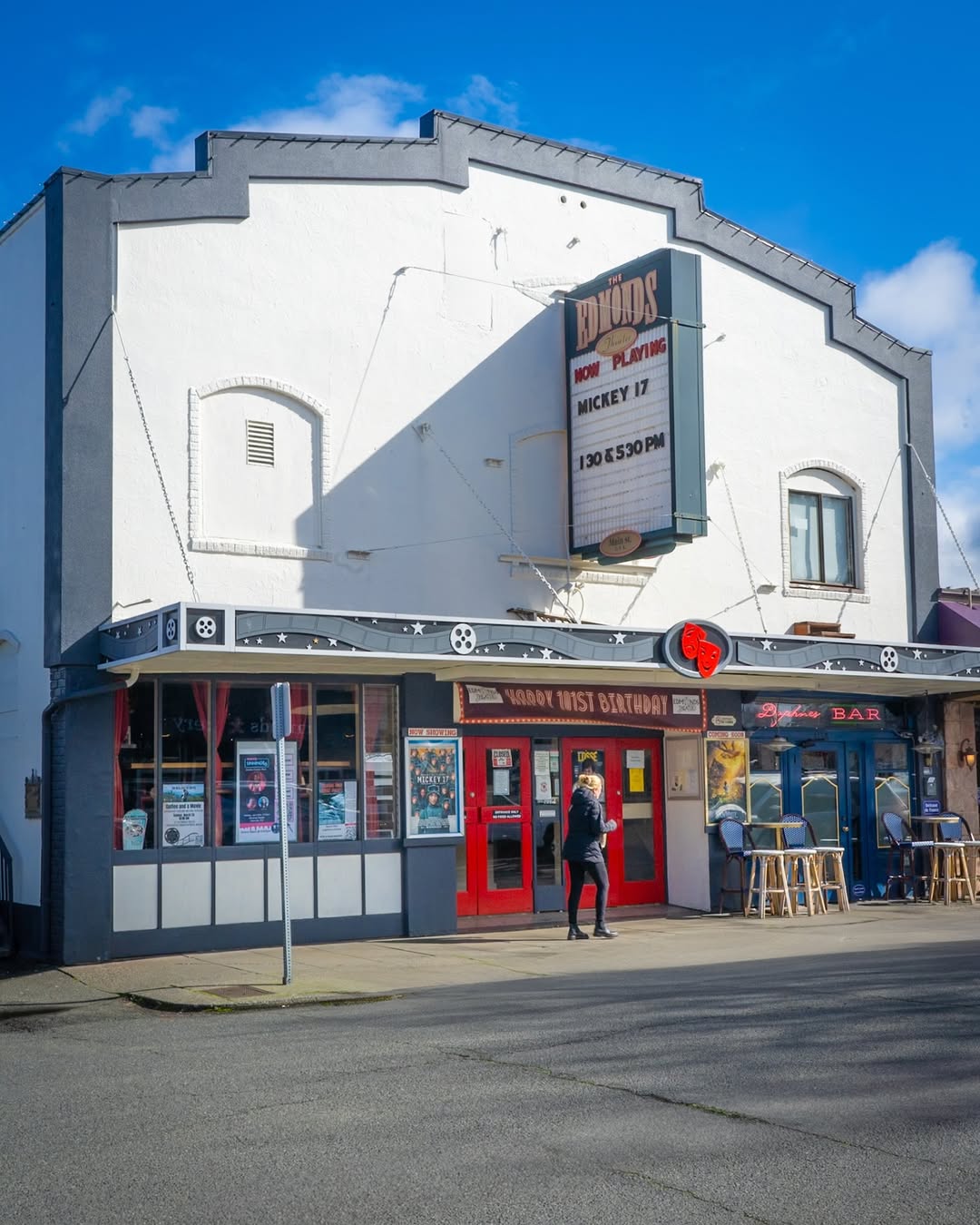 |
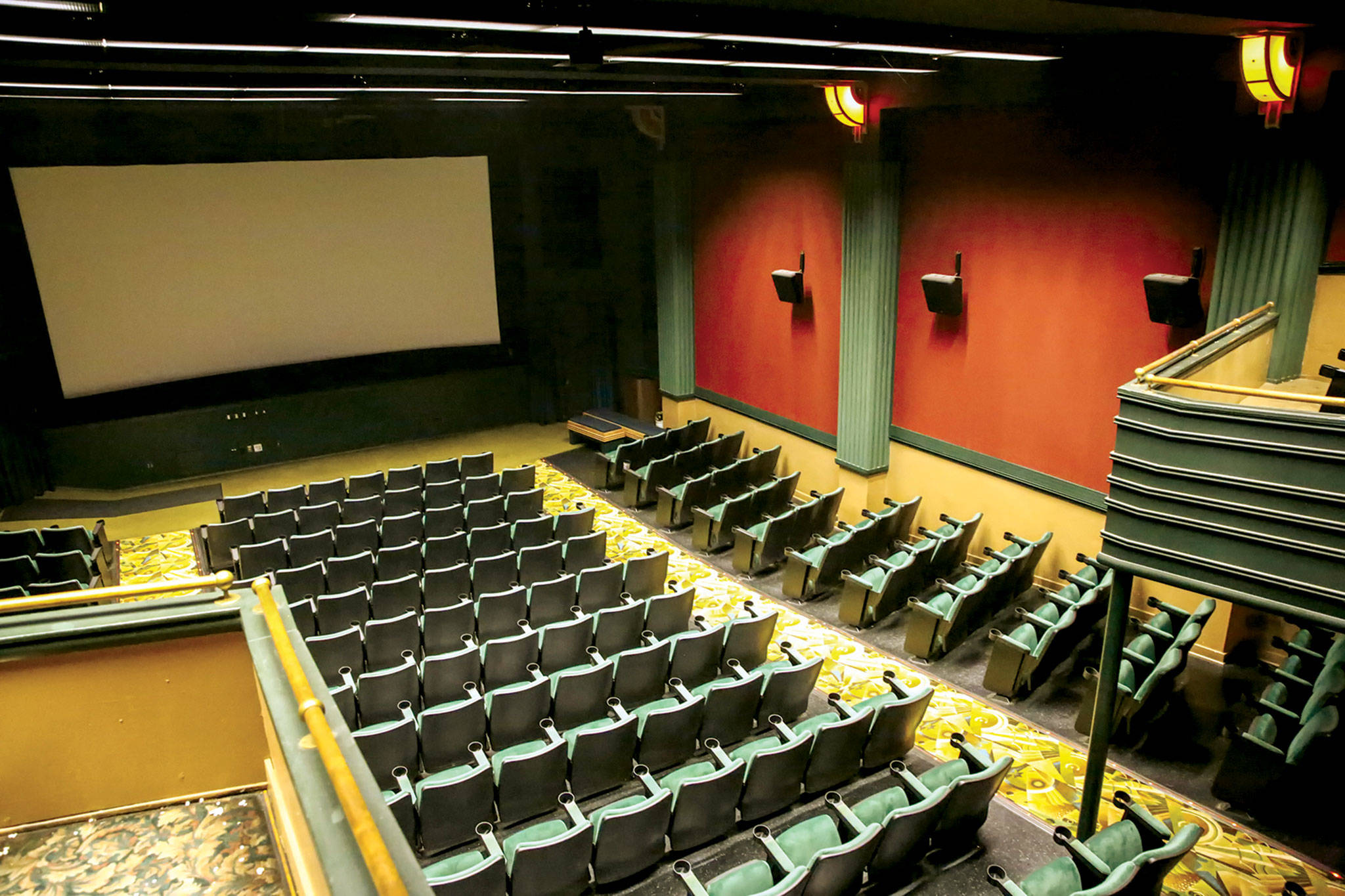 |
Built in 1923 with 250 seats, including the balcony. After a remodel in 1999 it had 240 seats. Reportedly there are only about 50 single screen theaters left in the country.
- "The Edmonds Theater is a single-screen survivor", HeraldNet, 1 Nov 2020
- "A brief history of the Edmonds Theater", myedmondsnews.com, 7 Aug 2022
- "Surviving the depression, a pandemic and now Netflix, the Edmonds Theater turns 102", King 5, 19 Jun 2025
- "Edmonds Theater", cinematreasures.org
Everett Mall Cinemas
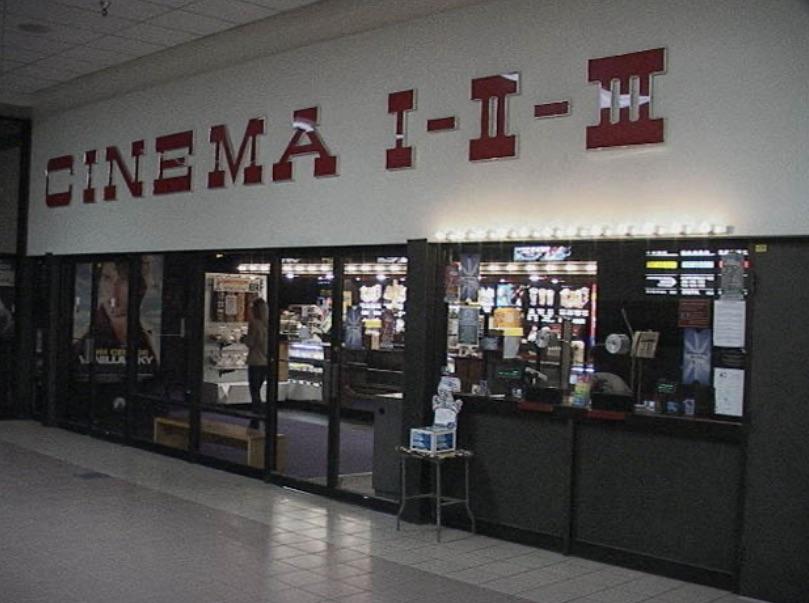 |
 |
General Cinemas opened three screens in 1973 in the Everett Mall next to the White Front. In 1977 they opened three more screens in an exterior building west of the Sears. The exterior location was given 4 more screens in 1982. I saw "Buck Rogers in the 25th Century" at the exterior theaters with Dad.
General Cinema went out of business in 2002 and 7 exterior screens were closed immediately, but Regal operated the three screens attached to the mall until 2006. According to a comment on cinematreasures.org, the exterior building has been demolished, but the 3 auditoriums attached to the mall are still there.
Grand Cinemas
18421 Alderwood Mall Boulevard, Lynnwood, WA
Perhaps the nicest theater in the area when it opened with 5 screens in 1981. Expanded to 8 screens in 1985. Closed in 2005. I believe the original building was where the Kohl's is today.
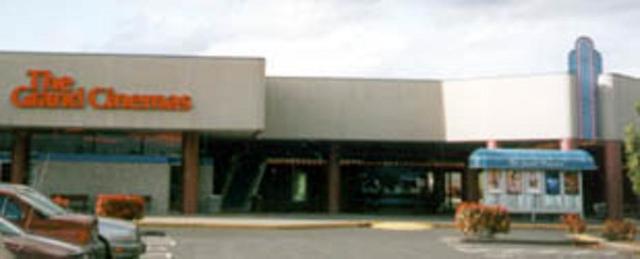 |
Grand Illusion
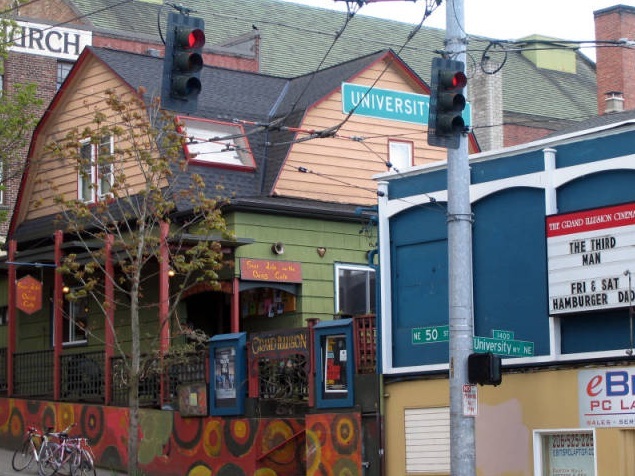 |
 |
This was Randy Finley's first theater. He converted a dentist's office and opened it in 1970 with seats for 70. The original name was "The Movie House"—it was renamed the "Grand Illusion" in 1979. It closed in 2025.
- "The Grand Illusion Cinema", Seattle Now & Then, 6 Apr 2023
- "Grand Illusion Cinema", cinematreasures.org
Guild on 45th
Lynn 4 Theater
Built in 1963, expanded to four screens in 1977. I saw "Pete's Dragon" there, which was released in November of that year. The theater closed in 1986, and the building was demolished in 2012.
 |
Metro 10
Neptune Theater
Puget Park Drive-In
 |
 |
 |
 |
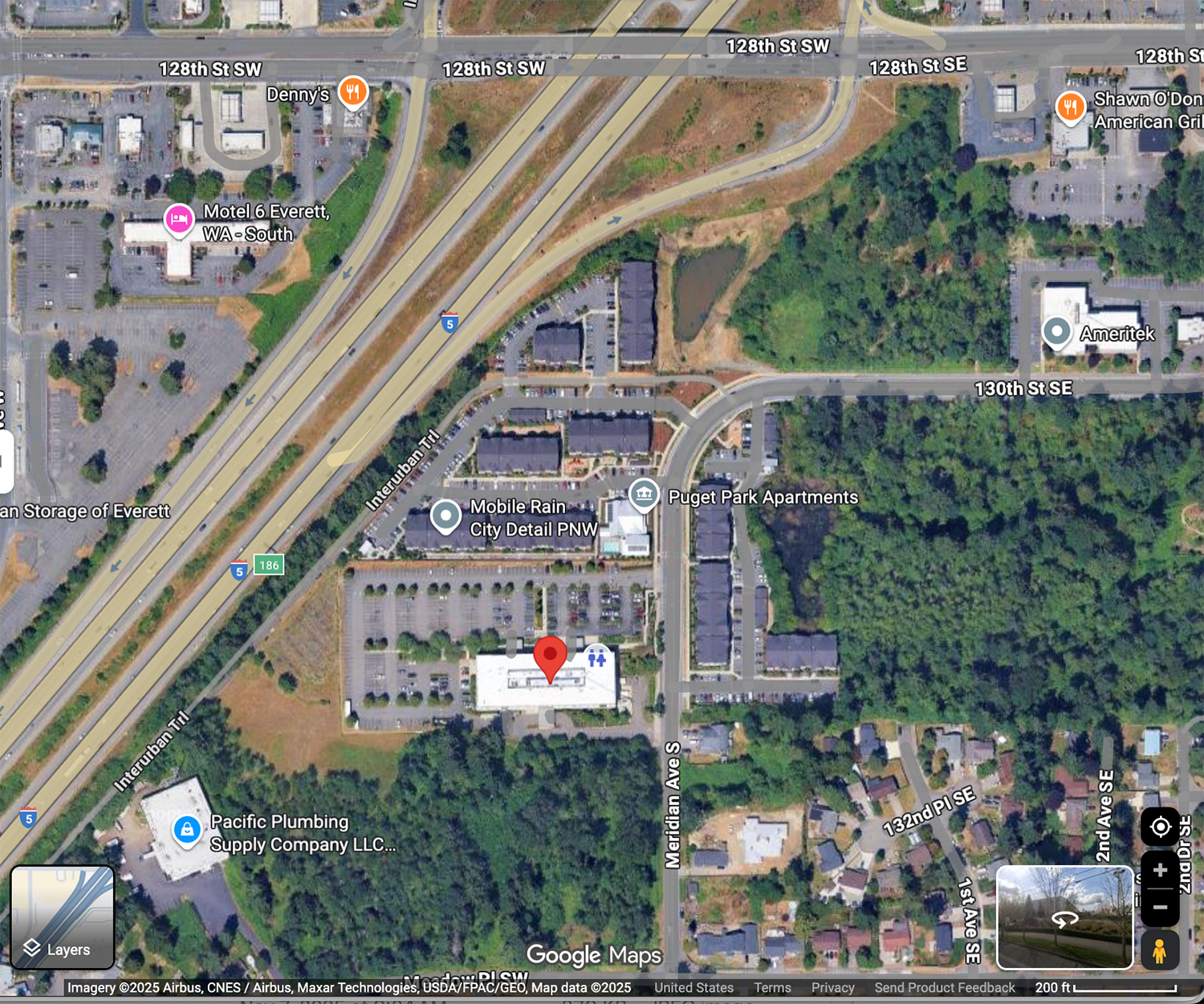 |
This theater opened in 1968 and closed in 2009. It was the last drive-in in the Seattle area on the east side of Puget Sound. It was close to my high school, but I never saw a movie there. I did go to the swap meet that was held there in the 1970s.
The Los Angeles Times article from 2013 appears to be the source of some oft-repeated facts about drive-ins: that the first one opened in 1933, and that at their peak in the late 1950s there were more than 4000 theaters in the United States and that was a quarter of the screens. Today the number is around 300.
- "Digital projection has drive-in movie theaters reeling", Los Angeles Times, 19 January 2013
- "Puget Park Drive-In", cinematreasures.org
Ridgemont
 |
 |
It opened around 1920. Apparently it was showing porn when it was acquired by the Seven Gables Theaters in 1978. I saw "Withnail and I" here in the summer of 1987. It stopped showing movies when Landmark acquired the Seven Gables Theaters in 1989, but it continued to be used for live theater until the building was demolished in 2001.
Seven Gables Theater
Sno-King Drive-In
17420 Highway 99, Lynnwood, WA
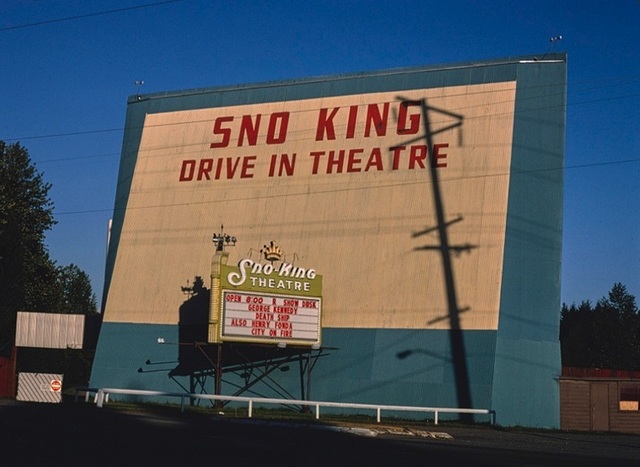 |
 |
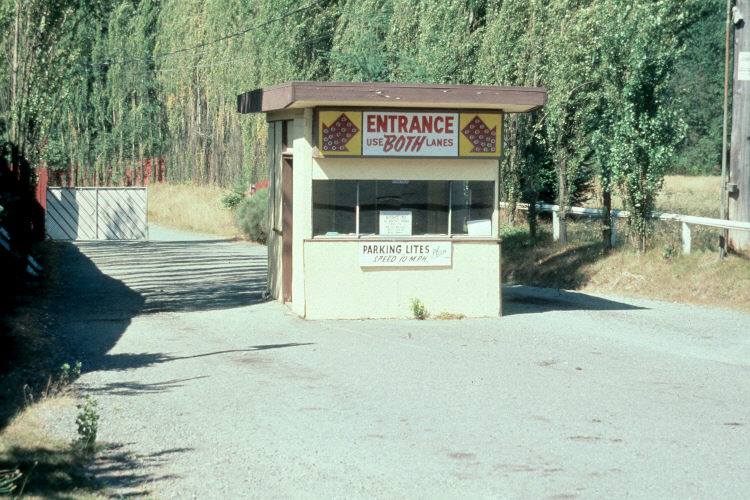 |
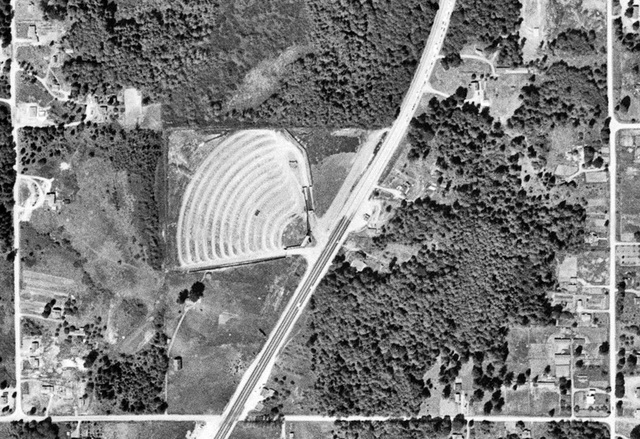 |
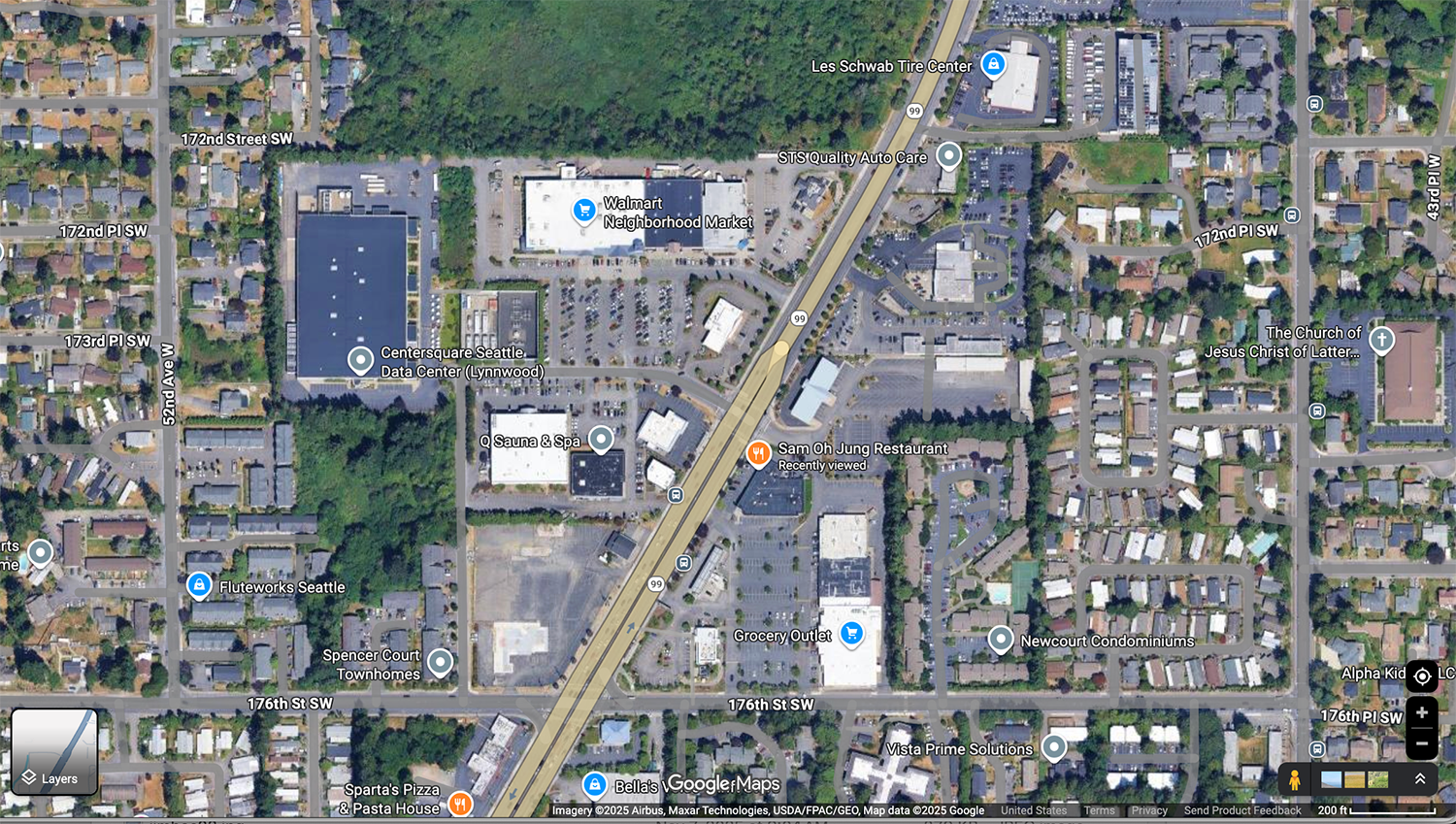 |
The theater was built in 1948 and the aerial photograph taken in 1952 shows that there wasn't much in the neighborhood, at least along Hwy 99. I went to the drive-in at least once, but I don't remember what I saw—I just remember it wasn't a very good movie watching experience. There was this magical experience I had when I was really young. We were driving at night and I saw a horizontally compressed image of a face talking as it floated in the night. It was some sort of atmospheric phenomenon, I thought—sheet lightning maybe.
The theater closed in 1986. The 2nd image shows the last double feature to play at the Sno-King: "Howard the Duck" and "Back to the Future".
Varsity Theater
4329 University Wy NE, Seattle
 |
The building was built in 1921. A single screen theater opened in 1940. It became part of the Seven Gables chain and two upstairs screens were added in 1985. I saw "A Room with a View" there in 1986. Landmark acquired the Seven Gables chain in 1989 and sold the theater in 2015.
Restaurants & Bars
Alfy's Pizza Lynnwood
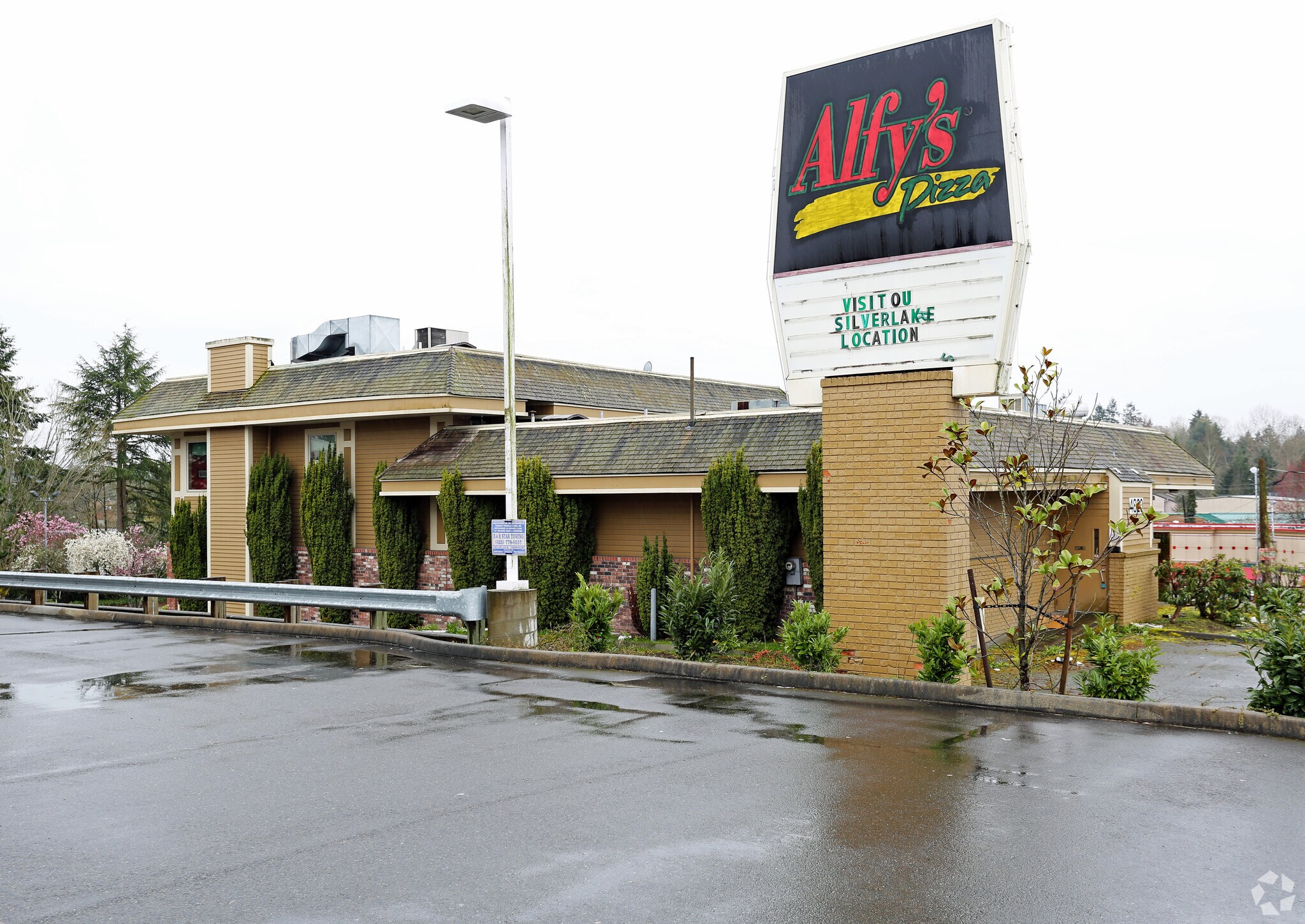 |
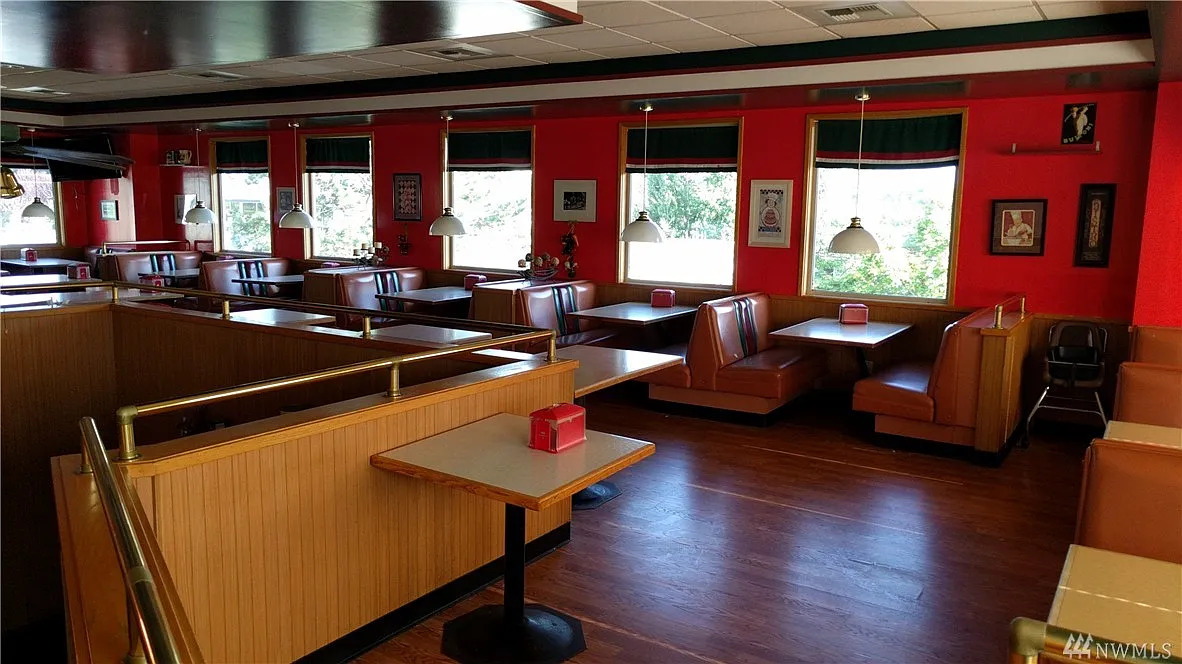 |
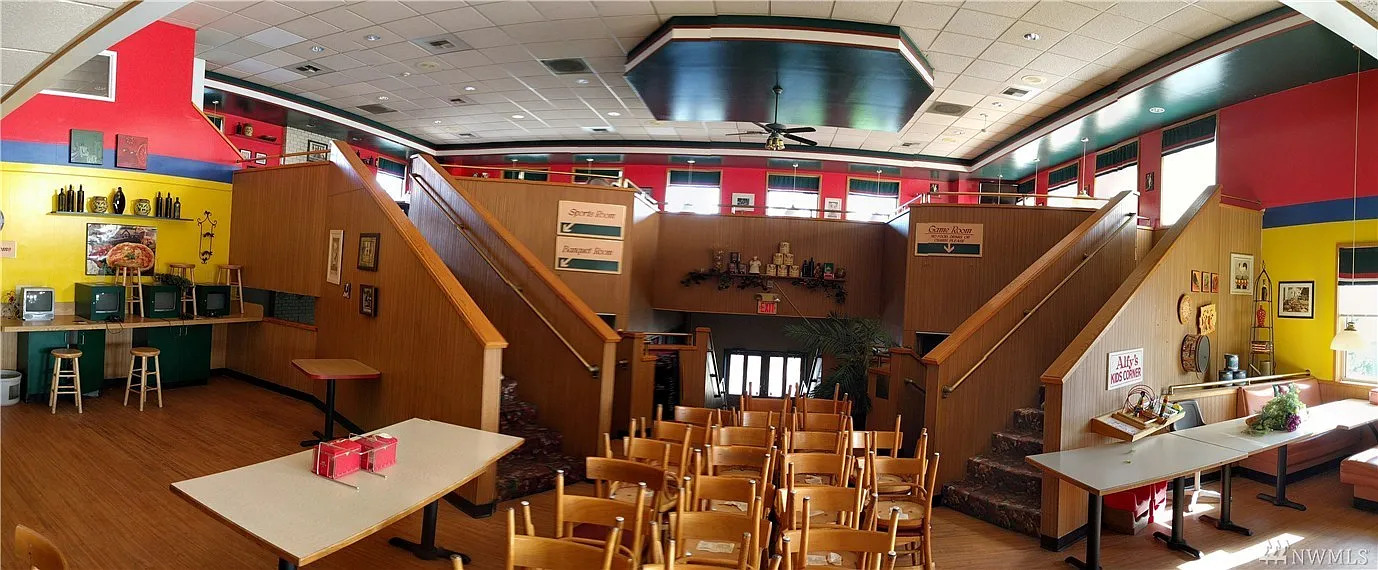 |
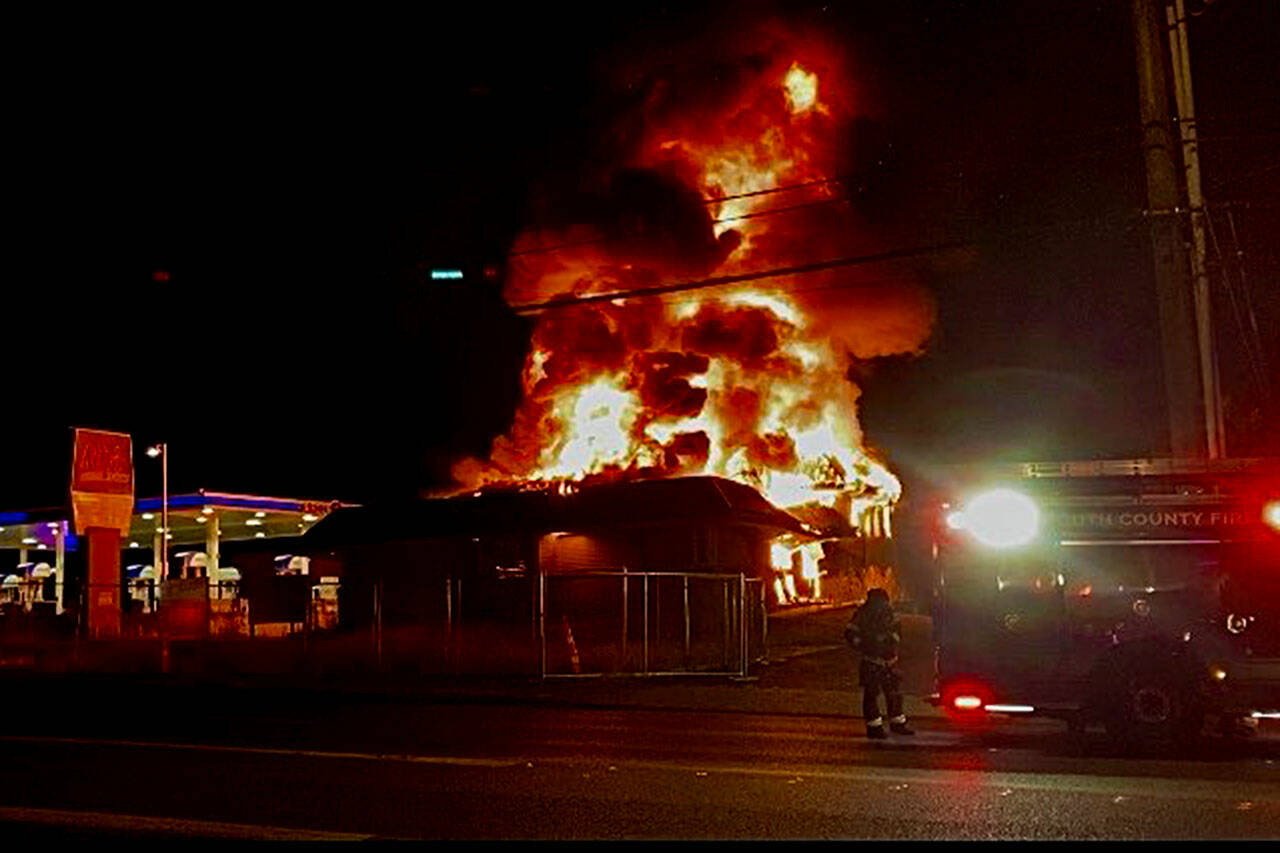 |
The Alfy's in Lynnwwood was listed on Zillow in 2017, perhaps soon after the restaurant closed for good. The building sat vacant until it burned down in 2022.
The building was built in 1978. The entrance was in back and the dining area was an open area with a high ceiling. I remember the interior as being dark, with purple paint and lots of wood finish. The Seattle Times article from 1991 mentions the chain being remodeled for brighter colors and more windows. One of the interior pictures shows the stairs down to the "Game Room", which had coin-operated video games, and a "Sports Room", which had pool tables and foosball tables as I recall. Pizza parlors with video games were popular in the 1970s and the 1980s.
Alfy's was a chain of restaurants. The first was opened on Broadway in Everett in 1972 or some sources say 1973. This was not the same Alfy's on Broadway that closed in 2021, since the restaurant relocated at some point. The Alfy's website says they have as of November 2025 locations in Granite Falls, Marysville, and Monroe. In the past there were also locations in Stanwood, Smokey Point, Oak Harbor, and two in Everett on Evergreen Way and at Silver Lake. There were also locations in King County.
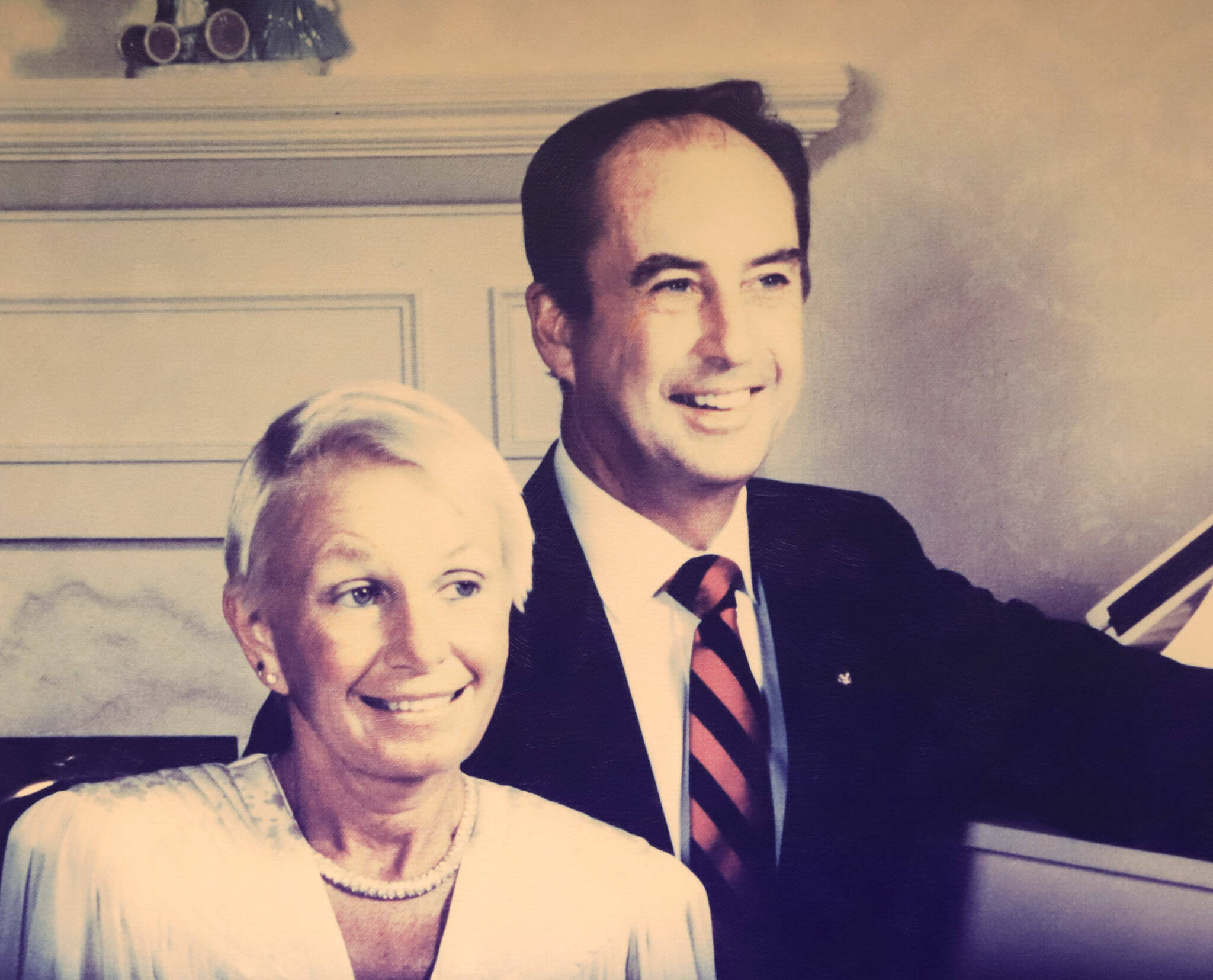 |
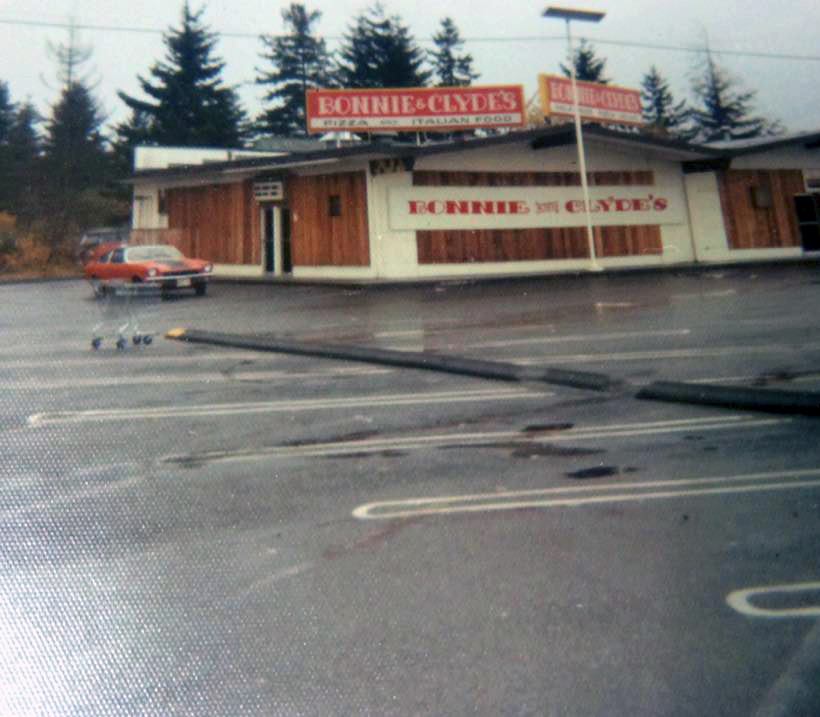 |
The pizza chain was founded by Bruce and Judy Olson, who got started in the business by buying a pizza place on Highway 99 near 196th (address?) which they renamed "Bonnie & Clyde's". The switch to the name "Alfy's" was motivated by a better location in the phone book, but both restaurants derive their names from movies in the 1960s. The chain used a central commissary where according the Seattle Times "each day the pizzas are made fresh... and shipped by truck to the various restaurants". It would have been the dough and maybe the sauce that was being made fresh daily.
The Olson's had a mansion in Mukilteo and two sons, Brian and Brett, who inherited the business when Bruce died in 1988. The family mansion was sold in 1999 and the restaurants were split up among various family members in 2012. A grandson also named Bruce Olson inherited the Evergreen location and the original commissary. Comments on various websites mention the quality of the food going down. You have to wonder if this is just due to changing tastes, but it might have been a consequence of the chain being split up and no longer using the central commissary.
- "Pizza Firm Sticks to Basics", Seattle Times, 24 July 1991
- "For sale: A $5M mansion expanded with Alfy's pizza dough", HeraldNet, 14 December 2021
- "Another Alfy's pizzeria closes", HeraldNet, 1 January 2022
- "Abandoned Alfy's in Lynnwood a total loss after fire", HeraldNet, 8 September 2022
- "It is with sadness...", Facebook, 30 March 2023, "Evergreen Way Alfy's Closing in April", reddit.com
- "Alfy's Pizza Locations"
Chuck E. Cheese
3717 196th St SW Ste. 100, Lynnwood
Opened in 1986. Closed in 2023.
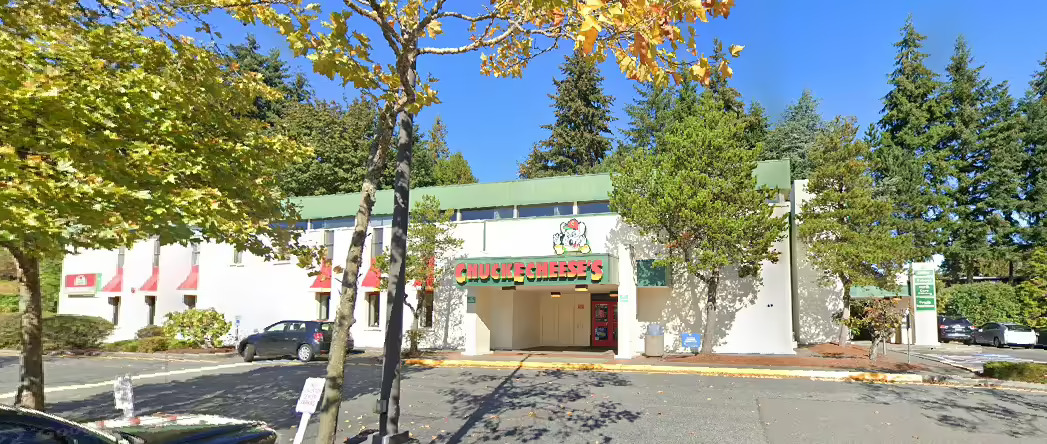 |
Godfather's Pizza
Harvey's Tavern
Opened in 1949.
Jimbo's Family Restaurant
We didn't eat at this restaurant very often and I don't recall ever wanting to eat there either. The Herald article says they were known for their burgers and their fish and chips, but I don't recall trying either of those as a kid. Their hot dogs didn't do anything for me.
James Anderson bought Bings Burgers in 1963 and renamed it Jimbo's. Which sounds like his nickname, so I suppose he named the restaurant after himself. He made a landmark out of the restaurant by erecting the large sign with the clock. The intersection of 196th and Hwy 99 was at that time the center of the newly incorporated city of Lynnwood. Interstate 5 came through Lynnwood in 1965 and the city would expand along 196th to meet it, but the location of the restaurant, which closed in 2008, is still prime commercial real estate.
Anderson's daughter Cindi Benoit took over the restaurant in 1983. She sold it to George Ageladaris in 1999.
 |
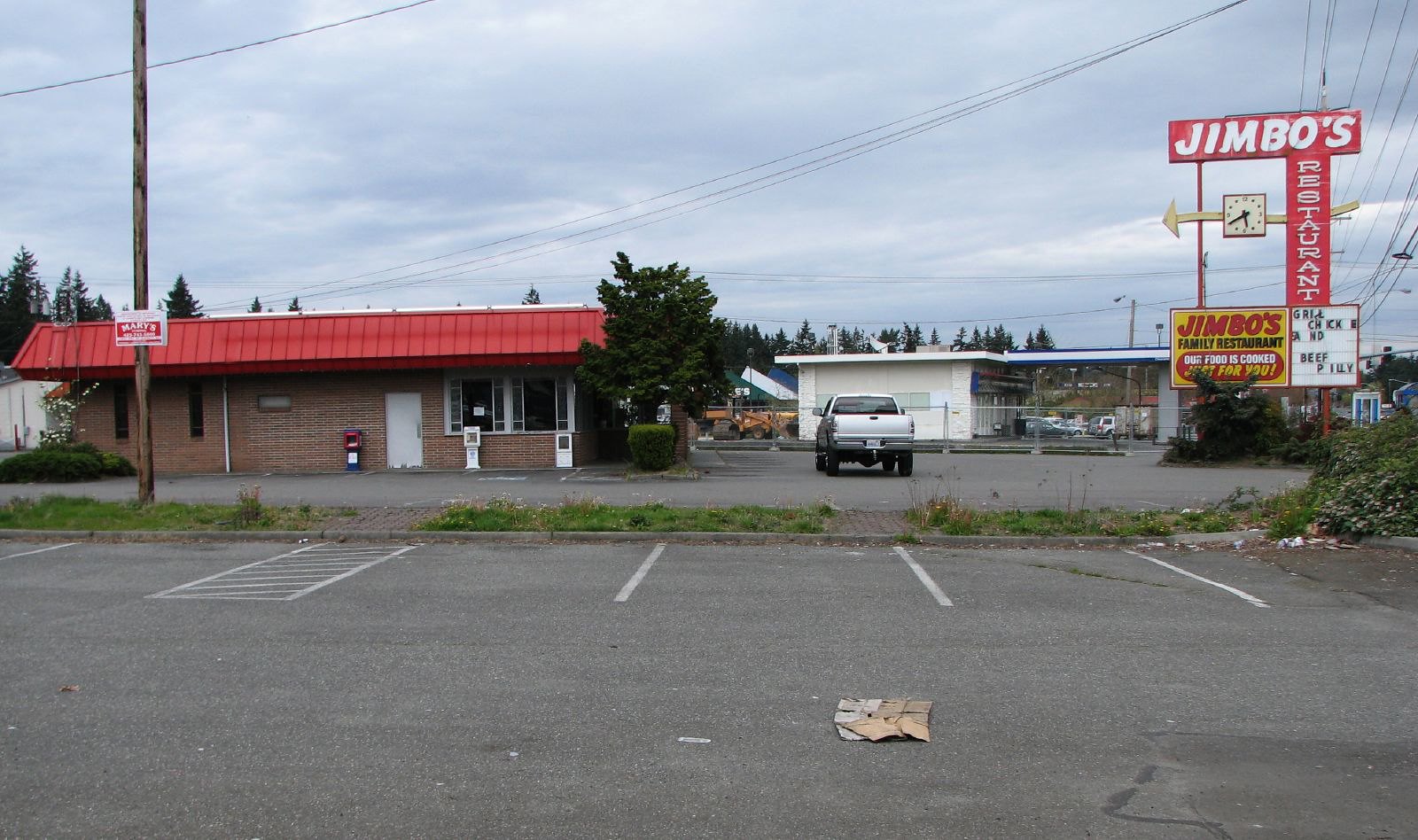 |
Kidd Valley University District
 |
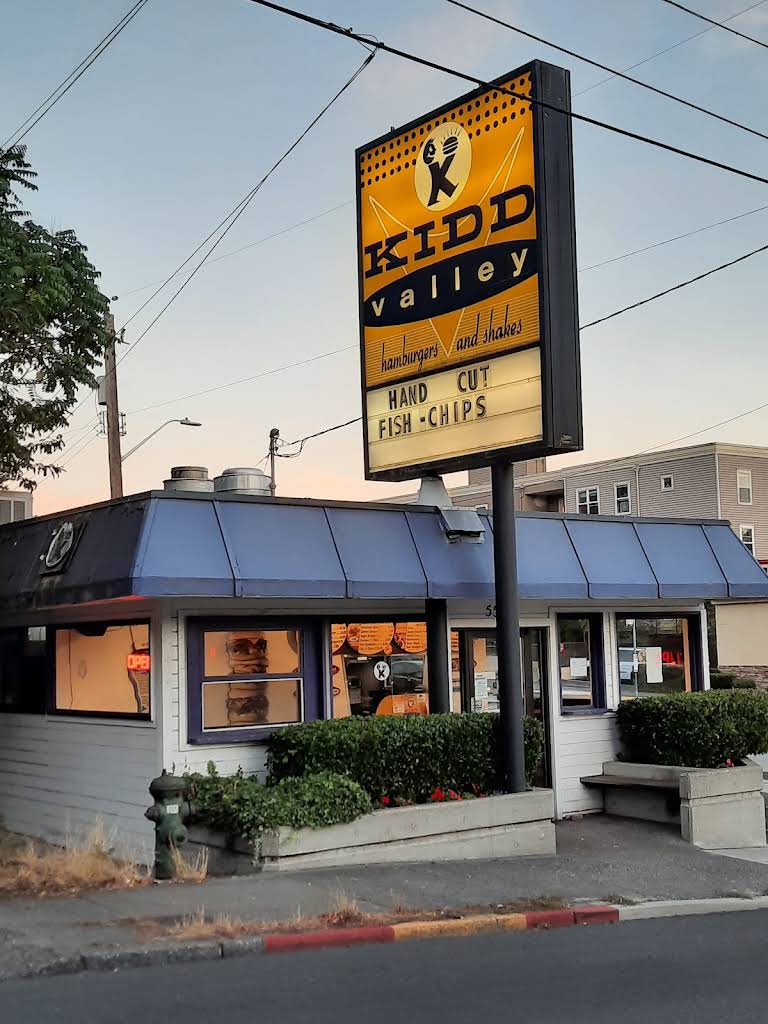 |
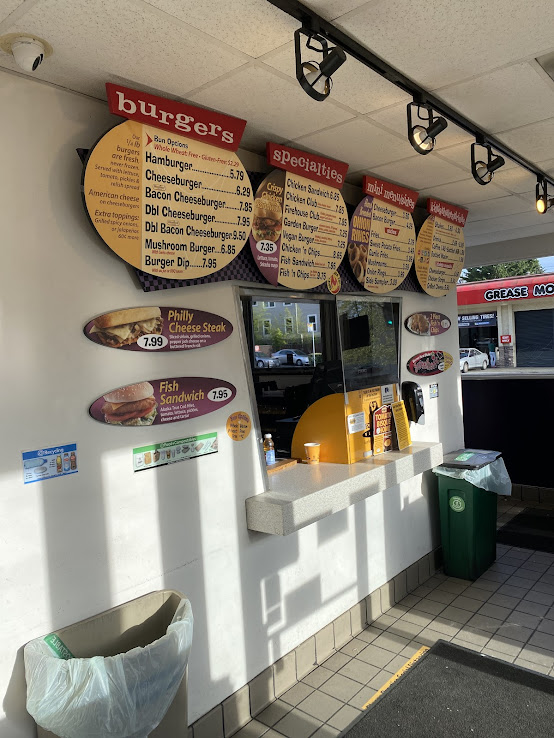 |
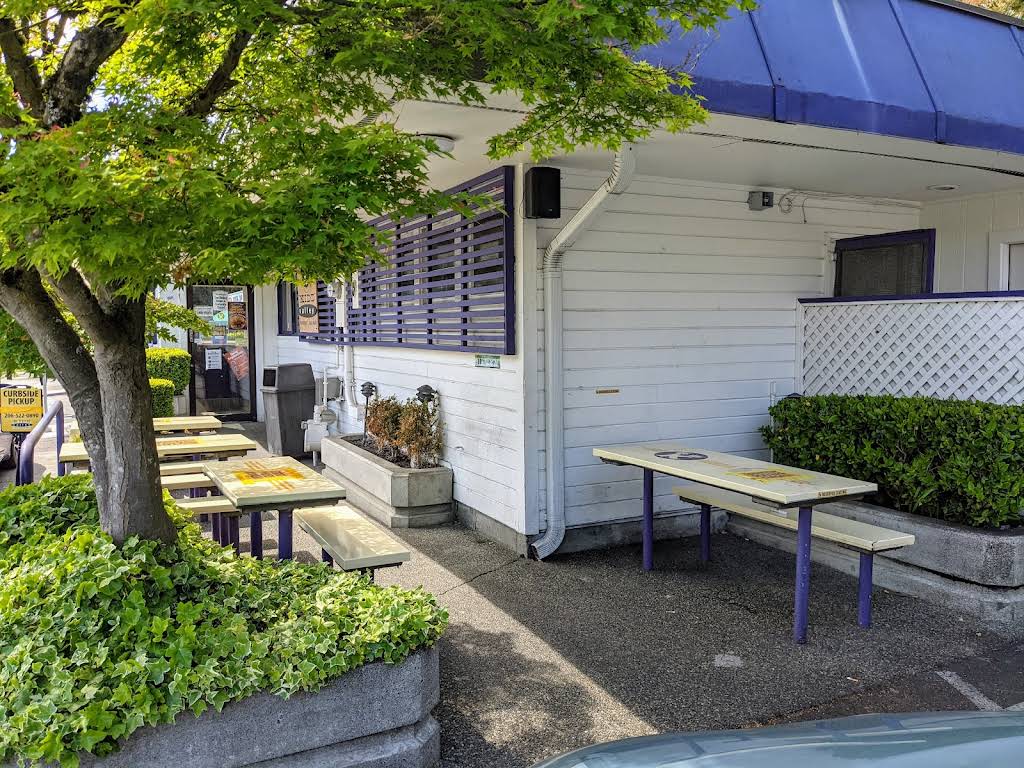 |
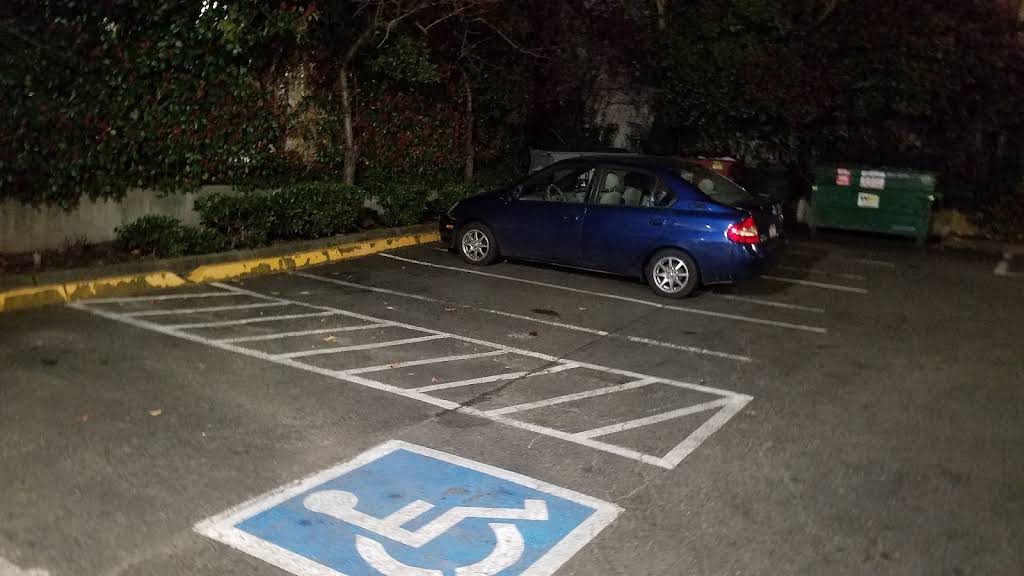 |
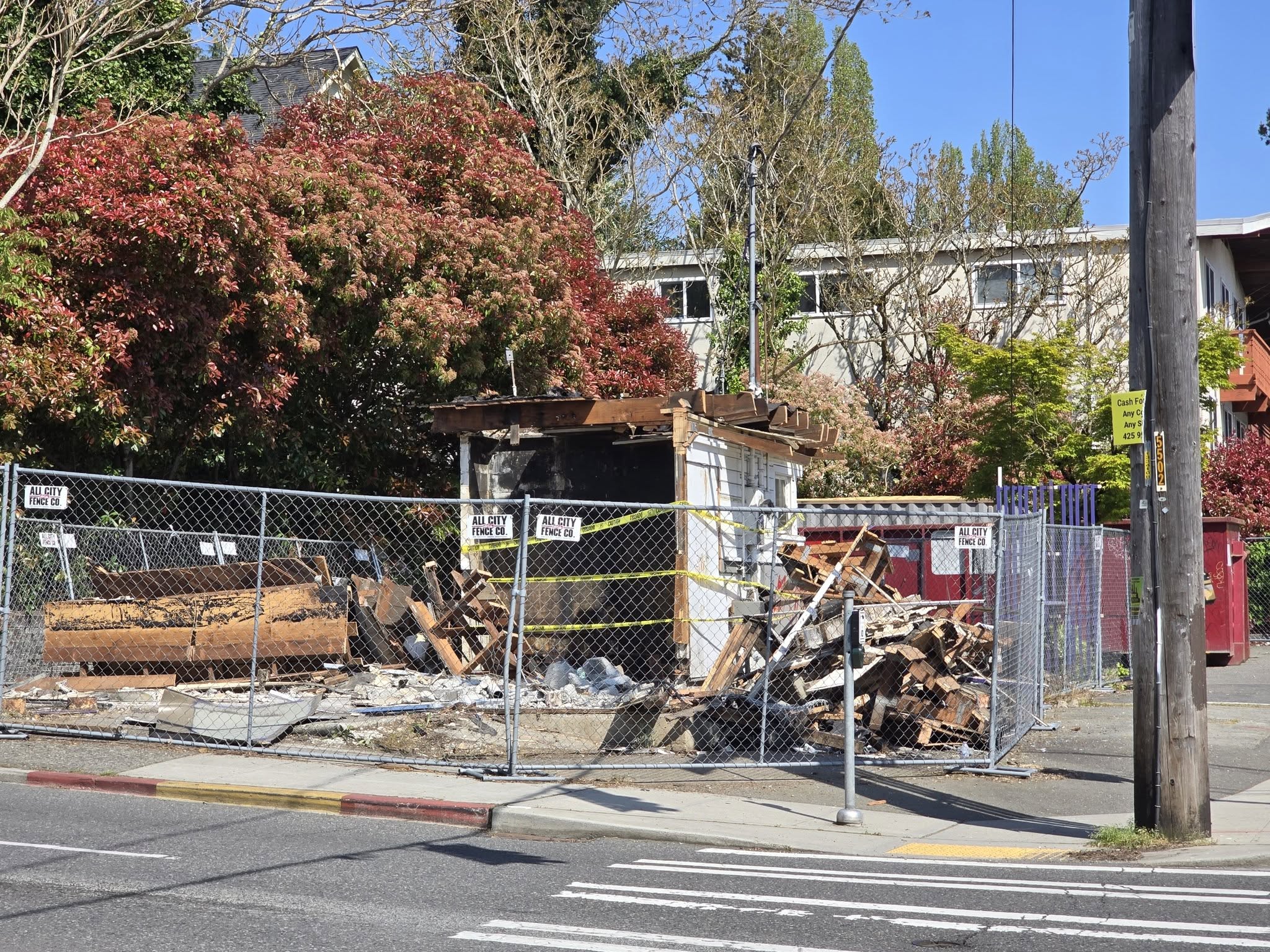 |
I ate here a lot when I was a student at the University of Washington. It was close to the Silver Cloud Inn that I worked at as a night clerk. I didn't realize at the time that it was the original location, opened by John Morris in 1975. It was a true hamburger stand: only 800 square feet of interior space. The pictures on Google Maps show counters inside with 8 stools, and 4 outside tables. The parking lot had room for 4 cars. It was remodeled at some point since I used to eat there. I remember counters of natural wood with graffiti carved into them.
Morris expanded Kidd Valley to 7 stores and sold to Ivar's in 1989. However, there are only 3 stores now. When the company closed the University District store, they blamed the Americans with Disabilities Act, which didn't sit well with some people in the comments.
- "Kidd Valley changed hands", Seattle Times, 23 Aug 2000
- "Our original Kidd Valley University store will officially be closing on 8/14/22", Facebook, 8 August 2022
- "Kidd Valley announces closure of original 1976 restaurant in University District", reddit.com, 8 August 2022
- "Original Kidd Valley in Seattle's University District closing its doors after 46 years", KOMO News, 9 August 2022.
- "The end of an era: demolition of the Kidd Valley building at 5502 25th Ave NE", Facebook, 24 April 2025
- "Locations", kiddvalley.com
Last Exit on Brooklyn
Red Robin
Original location at Fuhrman and Eastlake closed in 2010. The building was demolished in 2014.
Sambo's Lynnwood
There was a Sambo's in Lynnwood. I'm pretty sure I ate there at least once, since I knew about the tigers turning to butter. I remember it being close to Hwy 99, but an online source says it was where the Applebee's is today. The chain supposedly grew from 98 restaurants in 1969 to 1117 restaurants in 1979. By 1982 all them closed, though some would re-open under a different name or be sold to other restaurant chains.
Articles on Sambo's tend to make a morality tale out of the restaurant chain, seeing the name as a slur and hailing the downfall of the chain as a civil rights victory. But the main reason for the company's decline appears to be a ruling the SEC made in 1978. Supervisors at the company had revenue sharing and they could pay to increase their share. The company was booking those payments as sales and this was the practice that the SEC disallowed, since the company could buy back the revenue fraction the supervisor was earning if the supervisor left the company. The company then canceled the revenue sharing program and a lot of managers left. The company immediately became unprofitable and stayed that way until it went bankrupt.
Let's hope a picture of the Lynnwood Sambo's turns up some day. Googie archictecture has a lot of appeal to me now, though it seemed dated at the time. I would also like to find out when the Lynnwood restaurant was built. I don't recall it as being new. The Denny's across the street was built in 1972.
The Denny's might not qualify as Googie, but when I was in high school it still had distinctive light fixtures dating from the Googie era. The charm has since been eliminated by a remodel done probably in the 1990s.
- "Mistakes At Sambo's", The New York Times, 27 November 1981
- "Sambo's Restaurants in Washington", sambosonline.com
- "4109 196th St SW Lynnwood", remax.com
Shari's
James village location opened in 1993.
Malls & Shopping Centers
Alderwood Mall
Aurora Village
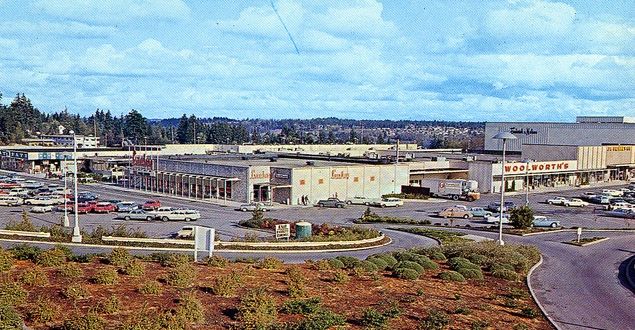 |
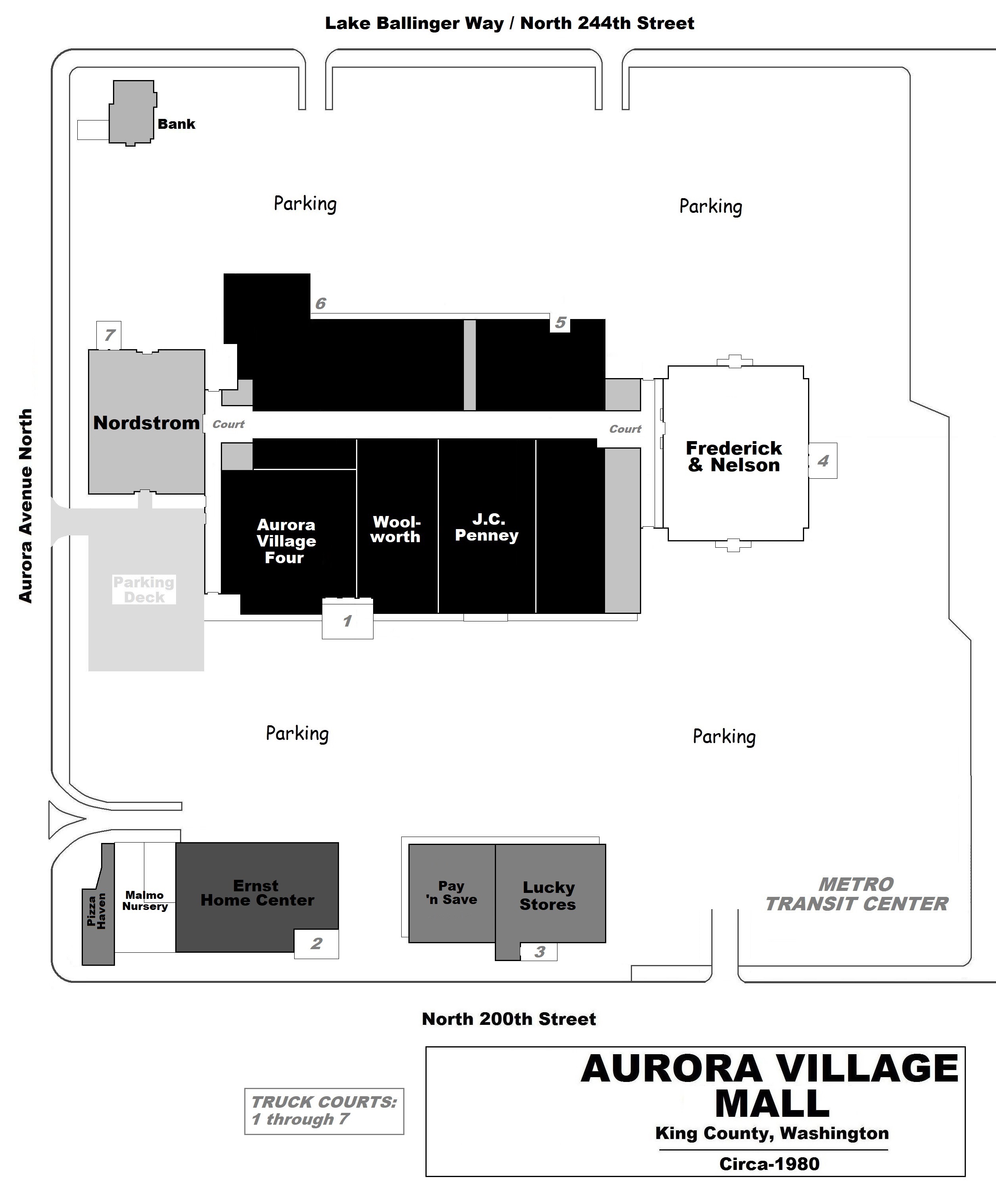 |
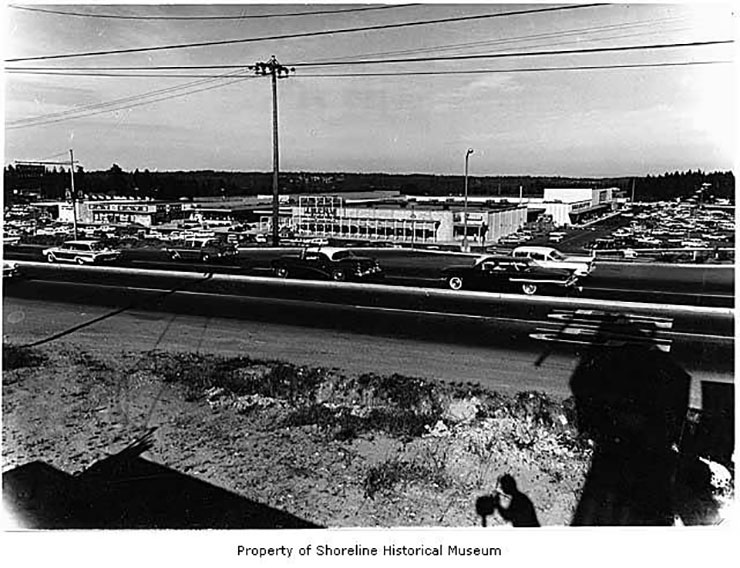 |
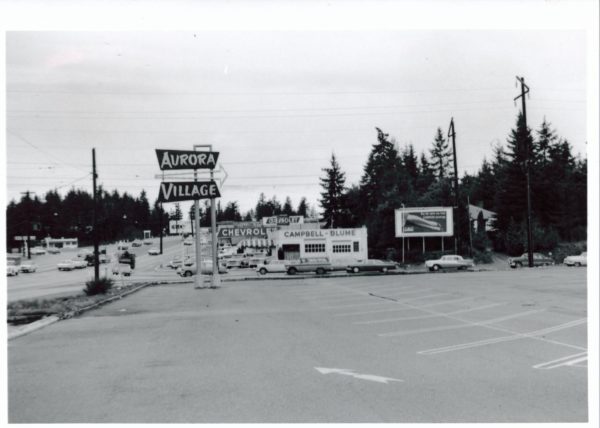 |
The mall opened in April 1960 with a Pay 'n Save Drug and a Lucky Stores supermarket.
An Ernst Hardware and a J.C. Penny were added in 1961. A Frederick & Nelson department store was added in in 1963. Ernst Hardware relocated to a freestanding building in 1967.
A Nordstrom opened in 1974. A parking deck was added next to the Nordstrom.
Lucky and Pay n' Save moved to freestanding buildings in 1977. The mall was enclosed and became climate controlled in 1980.
The old Lucky location became the Aurora Village 4 cinemas in December 1980. I don't remember visiting the mall very often. We were more likely to go the Everett Mall before the Alderwood Mall opened in 1979.
The Alderwood Mall was probably what put the Aurora Village into decline. J.C. Penny closed in 1986. Frederick & Nelson closed in 1991, and Nordstrom in 1992. The mall was demolished in 1993. A Costco opened on the site in 1994 and a Home Depot around the same time.
- "Aurora Village Center", Mall Hall of Fame, August 2008
- "History of Aurora Village", Shoreline Area News, 25 February 2017
- "Aurora Village 1987 and 1991", KIRO 7 News
Everett Mall
 |
 |
The first store in the complex was Sears, which moved from their downtown Everett location at 2701 Colby in 1969. White Front opened a store in 1971. General Cinema opened what is said to be Washington's first triple screen theater in 1973. A mall between Sears on the west and White Front on the north east was opened in 1974, but White Front closed its store before the mall opened.
The Bon Marché opened a store in the location of the old White Front in 1977. Also that year General Cinema opened a second triplex of screens in a external building to the west of Sears.
In 1979 a south wing was added to the mall. Frederick & Nelson and Payless Drugs became tenants.
General Cinema added 4 screens to the exterior location in 1982.
Frederick & Nelson went bankrupt in 1991. Mervyn's took over the location in 1992, but closed in 2006. The Bon Marché was rebranded as Macy's in 2005. The Macy's closed in 2017 and the Sears closed in 2020.
General Cinema went out of business in 2002. Regal operated the three screens attached to the mall until 2006, when it opened the Everett Stadium 16 in the location of the Payless, which was rebranded to a Rite-Aid at some point, perhaps when Rite-Aid acquired Payless in 1996.
James Village
NW corner of 196th and Hwy 99.
Lynnwood Center
SE corner of 196th and Hwy 99.
Lynnwood Square
SW corner of 196th and 44th
Northgate Mall
Old Milltown Mall
SW Corner of Hwy 99 and 196th St SW
University Village
Stores
Ed's Surplus
The Lynnwood store opened in 1967 and closed in 2018.
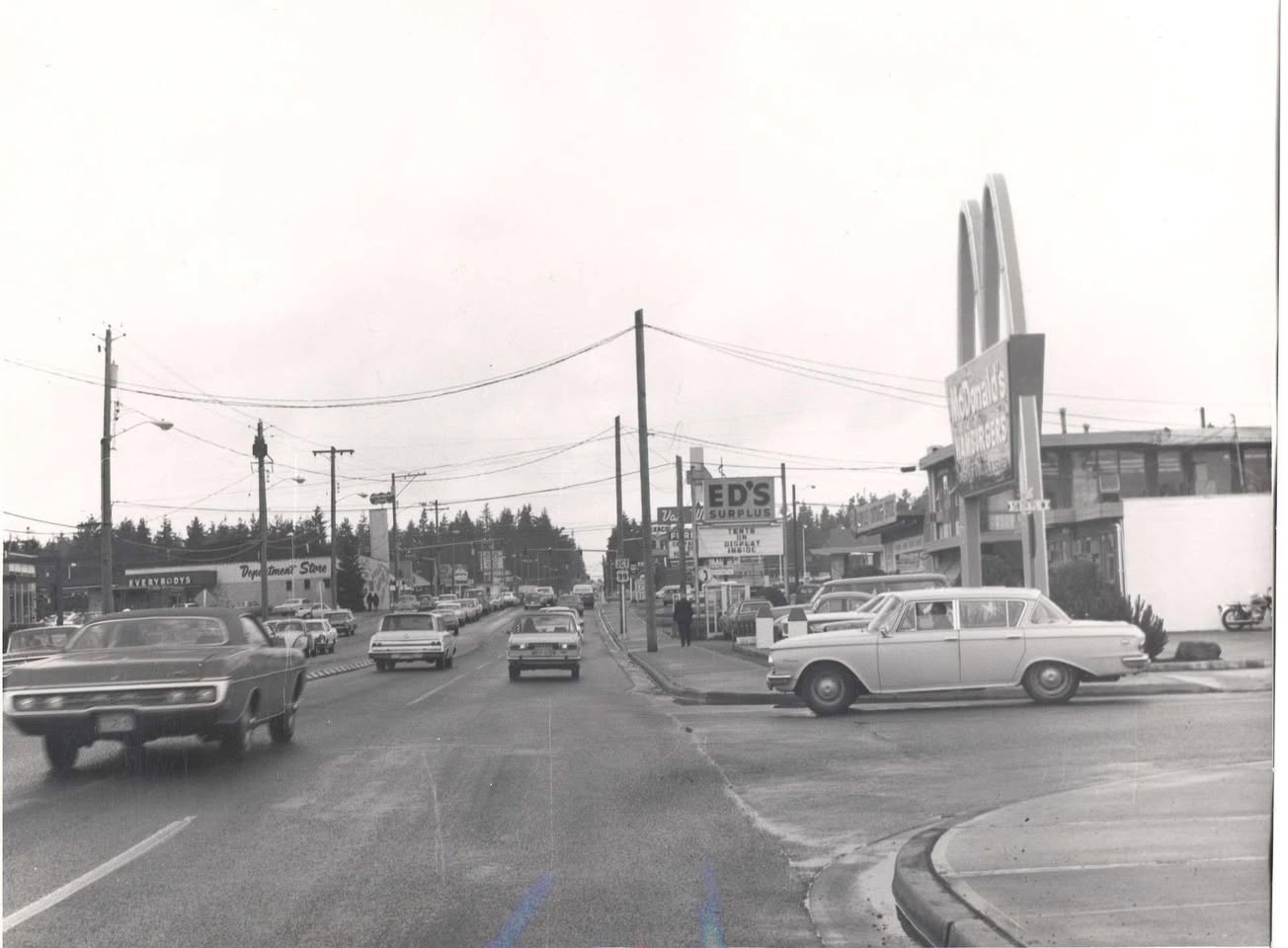 |
 |
Ernst Home Centers
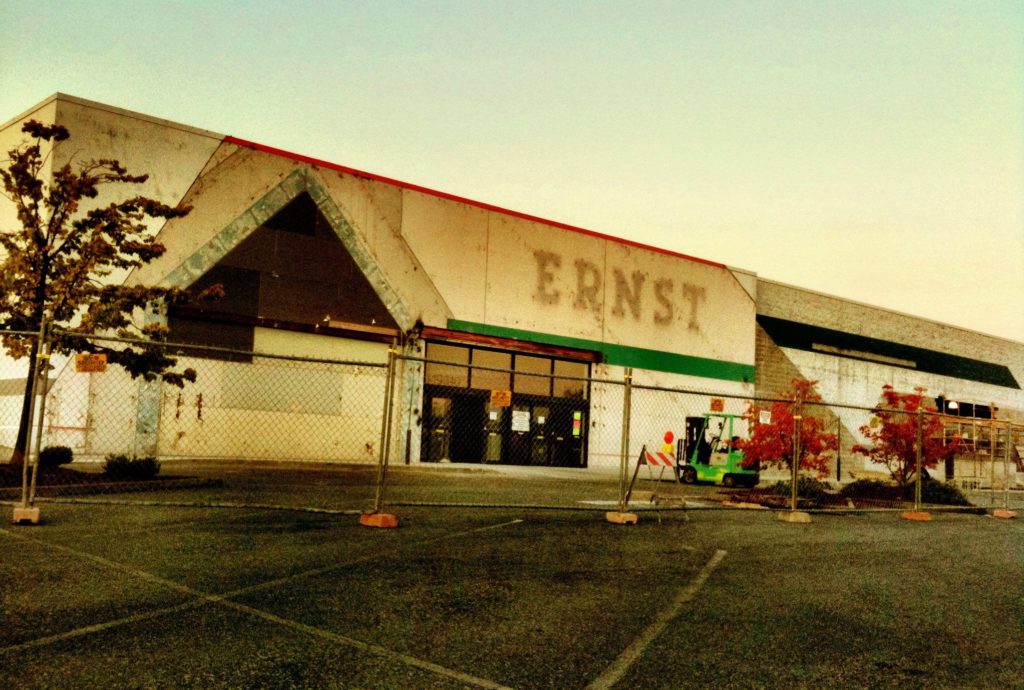 |
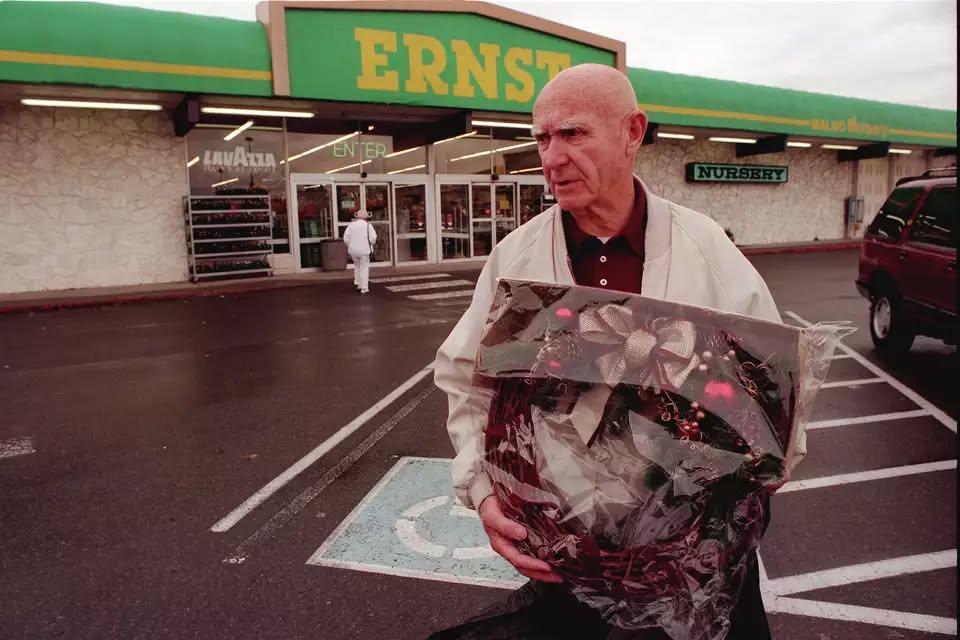 |
On the left a picture dated 8 September 2011, showing a G.I. Joe store in James Village being dismantled. The remodeling exposed evidence of the Ernst that used to be at the location. On the right, a shopper in front of the University Village Ernst during the liquidation sale in 1996.
Ernst Hardware was founded in Seattle in 1897. There were 9 stores when the drugstore chain Pay 'n Save acquired them in 1960. Ernst Home Centers were the dominant hardware store in the PNW when I was a kid. There was a location near the Alderwood Mall at 18420 33rd Ave W, Lynnwood. In 1981 I walked there with my friend and his brother—it was about 2 miles one way—and bought a machete, which I brandished in the woods when we got back home. I didn't have it long. Mom probably got rid of it so that I didn't chop off my fingers.
There were 95 Ernst stores when the chain was at its peak. In the 1990s Eagle Hardware and Garden started building stores that had more than 100,000 square feet in Washington State, and Home Depot also started expanding into the state with similarly sized stores. You might wonder where Eagle is today and the answer is that it merged with Lowe's in 1998. It would seem that in the face of this new competition, Ernst found itself with stores that were too small. Home Depot opened a store with 108,779 sq. ft of floor space near the Alderwood Mall in 2021. In the map below, you can see the outline of the Home Depot store to the right. The Ernst, meanwhile, was the building on the left and south of 184th St SW. It was probably the unit labeled "Guitar Center" but also included the unit to the south of it. If I'm right about that, the Home Depot is three times the size of the old Ernst. The unit north of "Guitar Center" might have also been part of the Ernst, originally an outdoor area holding the nursery.
Pay 'n Save, the owner of Ernst, was acquired by Pacific Enterprises, a subsidiary of a gas company, in 1988, and was sold to Payless in 1992. Ernst was spun off as an independent company around this time and went public in 1994. However, it went bankrupt and closed its remaining 53 stores only two years later.
- "Home Depot Plans Major Expansion In Puget Sound Area", Seattle Times, 13 November 1991
- "Ernst Selling All Its Stores, Finally Going Out Of Business", Seattle Times, 12 November 1996
- "Hardware Giant Lowe's Buys Eagle", Seattle Times, 23 November 1998
- "Nine years ago in Lynnwood: Signs of the old Ernst Hardware", Lynnwood Today, 8 September 2020
- "Lynnwood welcomes its first ever Home Depot store", Lynnwood Times, 26 August 2021
- "Eagle Hardware & Garden, Inc", encyclopedia.com
Fred Meyer
House of Clocks
The business was started by Dale Nofziger in 1963. His children Susie Hennig and David Nofziger continued to run it until they reached retirement age in 2017. As of 2025 the building is still there, but it is not painted bright red, making it a bit less of a landmark. I have a vague memory of going inside, but I suspect it was manufactured.
The House of Clocks is close to a local high point at which the elevation is about 650' above sea level. The grade going up from Keeler's corner to the high point used to be called Gunny Sack Hill according to the Herald, which also claims that gunny sacks were used to help cars get up the muddy road before the highway was paved.
 |
Larry's Market Oak Tree
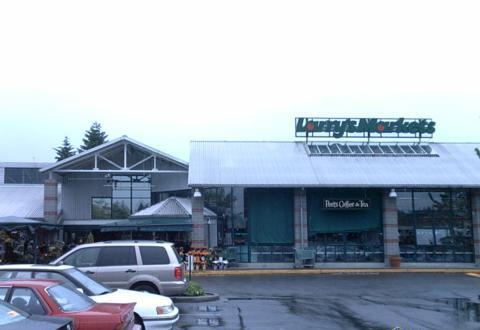 |
 |
Larry McKinney opened his first store in central Seattle in 1964. Ten years later he bought the corner market that his father opened in 1945 near Greenlake. It was the store that he opened in Oak Tree Village in the mid 1980s—or according to another source, 1989—that pioneered the concept of a high end grocery. I guess the niche is occupied by Whole Foods today, but I remember Larry's as being more exciting. I spent $50 on caviar there as a Christmas gift for my dad. In 1997 I rented a room on the other side of Aurora. One of the best grocery stores ever was a short walk away, but I wasn't cooking then.
- "Larry's Markets, upscale icon, loses out to the competition", Seattle Times, 9 May 2006
- "Larry's Markets Seattle", www.groceteria.ca, 11 July 2006
Manor Hardware
3699 195th Pl SW, Lynnwood
The building was constructed in 1918 as a school. The school closed in 1921 and the building was moved a short distance to the north and put on a new foundation, where it was used as a sales office for the Puget Mill Company and a post office. In 1947 Pope & Talbot sold the building to Lew Silvers, who opened Manor Hardware. Silvers sold the business in 1973, but the new owners continued to run the business until 1997. The building demolished between Aug 2011 and Oct 2015, and the lot is empty as of 2025.
Molbak's
Petosa's on Hwy 99 & Shelby Rd
When we moved to the Picnic Point neighborhood in 1976, there were no supermarkets nearby. There was a grocery named Petosa's on Hwy 99 and Shelby Rd. Petosa's was small but at least it had produce and a butcher's shop. The only other option in a 3 mile radius was the Day & Nite at 168th and 52nd. Day & Nite is still there, but it was larger back then if memory serves.
I think the Petosa's was run by the same Tom Petosa who opened the Petosa's Grocery in downtown Edmonds in 1986. It would have made sense for him to close his grocery on Hwy 99 after the larger Safeway opened at 148th in 1980. I haven't been able to find a picture of the original grocery on the internet, or much mention of the grocery at all. The current building, which contains a marijuana store, is not the building that housed the grocery.
Tom Petosa was from a large family and his siblings ran several restaurants in the area.
- "Petosas find their forte in restaurant business here", The Catholic Northwest Progress, 25 October 1974
- "Grocer Petosa’s generous spirit touched many", Seattle Times, 9 May 2005
- "Restaurant owner had sweet and spicy personality" HeraldNet, 17 December 2005
- "Edmonds’ Petosa’s Family Grocer to close", 26 December 2012
Safeway
14826 Hwy 99, Lynnwood
https://www.groceteria.ca/board/viewtopic.php?t=4586
Ted's Sport Center
15526 Hwy 99, Lynnwood, WA 98087
Opened in the above location in 1973 and closed in 2020. There was an earlier store with the same name that opened in 1968.
- https://www.washingtonflyfishing.com/threads/fyi-teds-sporting-goods.160259/
- https://www.fieldandstream.com/stories/fishing/ten-best-fishing-tackle-shops-usa
- https://flyfishing-shops.com/shops/ted-s-sport-center/
Toys "R" Us
Toy Town
16809 Pacific Hwy, Lynnwood WA
The store opened in 1979. It was gone by 1982 when Toys "R" Us opened at the Alderwood Mall. My sister remembers an entire aisle devoted to Barbie dolls and accessories. I remember the Dungeons & Dragons and Avalon Hill box sets over cabinets with lead minis and polyhedral dice.
The building which is there today is I believe the same, though the facade might not be original. I remember it as being gray. The store had 12,000 sq ft of retail space. It seemed gloriously large, but the Toys "R" Us had 43,000 sq ft of space.
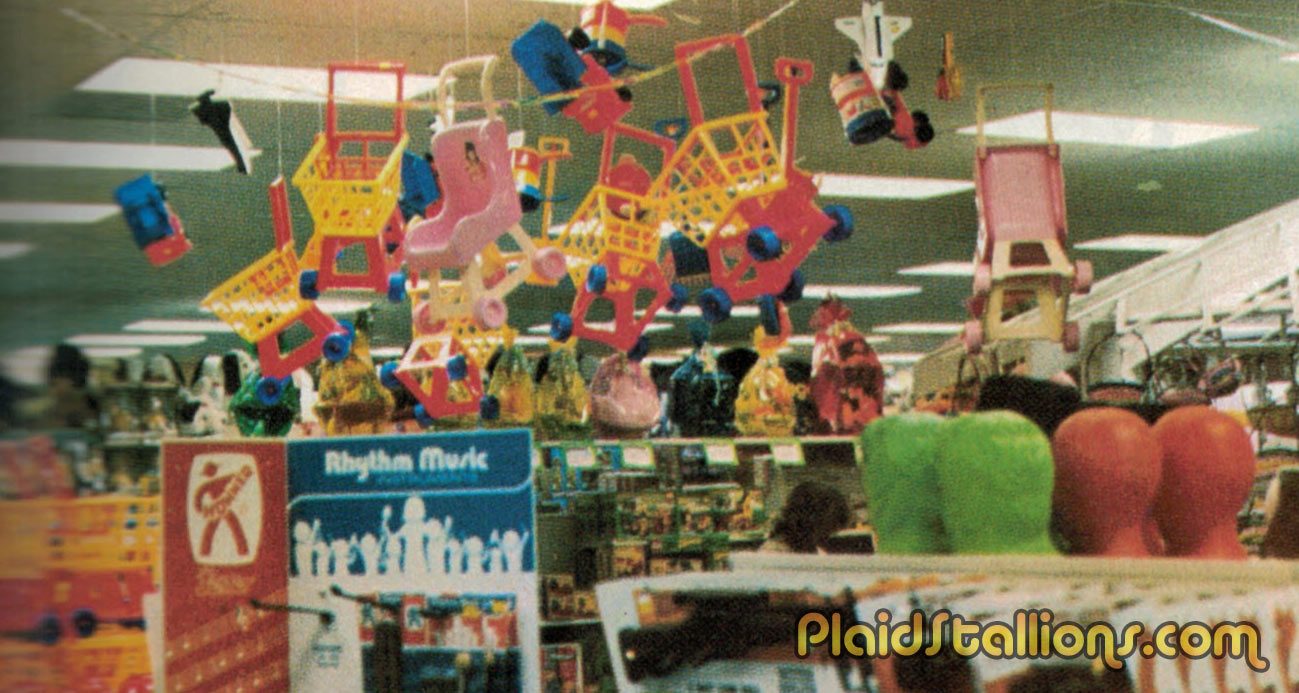 |
Wight's Home and Garden
Skating Rinks & Bowling Alleys
Everett Skate Deck
 |
 |
 |
 |
A skating rink was opened by Bobbie and Eric Englund at 2201 California St in 1961. The original building is now used as a sports arena.
The Englunds moved to the 19th Ave SE location in 1976. Daughter Teri Acklus inherited the property in 1979. Grandsons Ryan and Cory Acklus sold the 3.72 acre property for $2 million in 2022.
Lynnwood Bowl and Skate
6210 200th St SW, Lynnwood
- "Skate Deck hopes to open for customers, not take donations", HeraldNet, 17 January 2021
- "Everett Skate Deck, a place of youth and romance, will close", HeraldNet, 7 March 2022
- rink-history.weebly.com/everett-skate-deck-everett-wa.html
Large Buildings
Boeing Everett Factory
Built in 1967 to manufacture the 747.
Safeco Plaza
Built in 1975. Sold to the University of Washington in 2006 and renamed UW Tower. It is 325 feet tall and has 22 floors. It is the tallest building on the Sno-King Upland Plain.
Old Buildings
Keeler's Corner
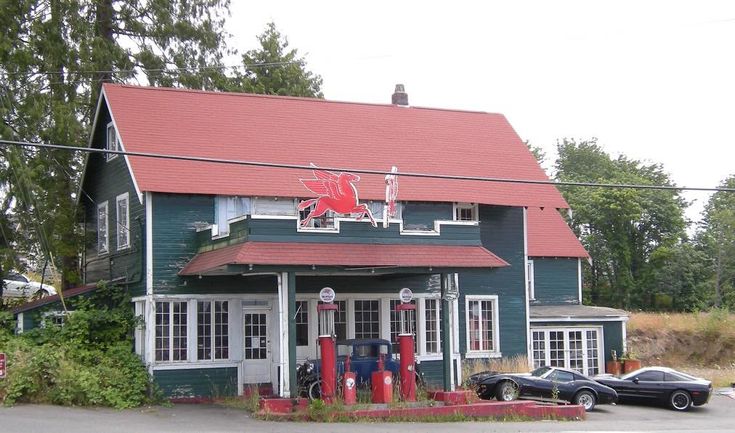 |
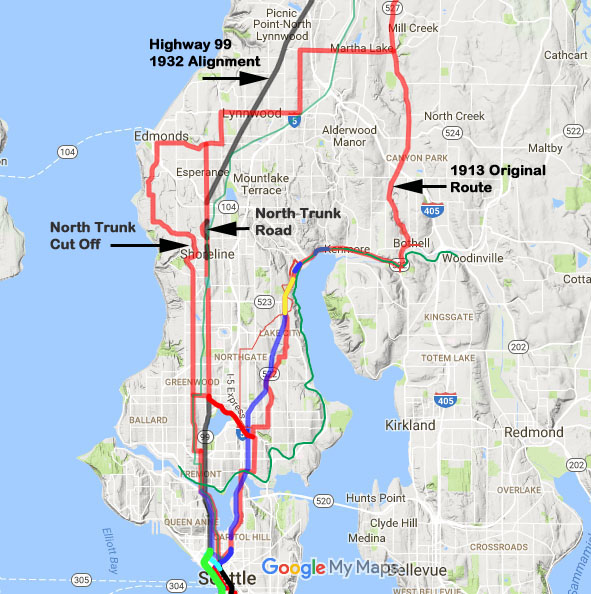 |
 |
Several sources say that it was built in 1927 when the Pacific Highway was straightened between the county line and Everett. In the 1970s it was no longer used to pump gas and instead it was used as an antiques store.
The first road connecting Seattle with Everett went from Lake City to Bothell and then took the route of what is today the Bothell-Everett Hwy (SR 527). The road from Lake City to Bothell was completed in 1887 and it was a by-product of the Seattle, Lakeshore, and Eastern railway.
The North Trunk Road was finished from Seattle to the county line in 1912. The road is Aurora Ave today. It was extended to Edmonds in 1915. From the county line it went north on 84th Ave W to 212th St Sw, and took what is today Bowdoin Way into Edmonds.
The 1924 Pacific Highway used the North Trunk Road. At 212th St SW it went east to 76th Ave W, then north to 196th St SW, then east to 36th Ave W, then north to 164th St SW, then east to the Bothell-Everett Highway.
I believe work began in 1924 to straighten the Pacific Highway and it was finished in 1927, but the map above gives what it calls the "Highway 99 Alignment" a date of 1932.
- "This Month in Edmonds History: North Trunk Road"
- "Transforming Highway 9", My Edmonds News, 11 May 2018
- "Lynnwood’s Keeler’s Corner Offers a Look Back in Time", Snohomish Talk, 5 May 2021
Mills
Scott Paper
In 1930, a large paper mill was built on Puget Sound north of Weyerhaeuser's Mill A by the Puget Sound Pulp and Timber Company. The mill was acquired by Soundview Paper Company, and by Scott Paper in 1951. Scott Paper ran a competition for high school students called Hi-Q which I participated in. Scott was acquired by Kimberly-Clark in 1995. The mill ceased operations in 2011 and was demolished in 2013. It was the last mill to operate in Everett.
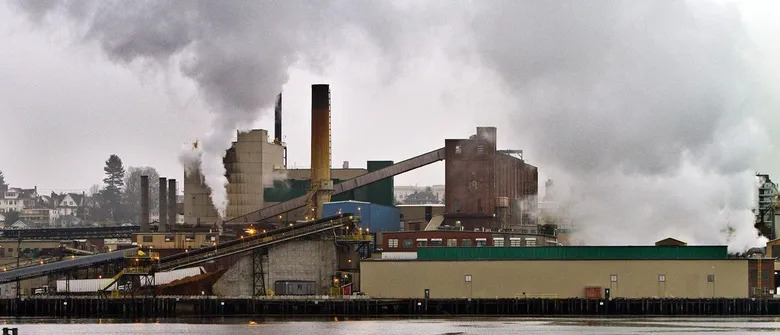 |
- "Scott Paper Co. Will Absorb Soundview Pulp Co.", New York Times, 6 Nov 1951
- "Kimberly-Clark’s plan to buy Scott for $6.8 billion reflects growing competition in household products industry.", Los Angeles Times, 18 July 1995
- "Kimberly-Clark to close Everett Mill and Pulp ", Seattle Times, 8 December 2011
- "Kimberly-Clark mill is part of the Everett we’ve lost", HeraldNet, 30 March 2012
- "Former Kimberly-Clark Mill Site", wikimapia.org
Weyerhaeuser Mill A
Port of Everett South Terminal
When James J. Hill brought the Great Northern Railway from St. Paul to Everett, he was supported in part by the land grants stipulated in Pacific Railway Act of 1862. In 1900 he sold 900,000 acres—about 2% of the land in Washington State—to Frederick Weyerhaeuser at a price of $6 an acre. Weyerhaeuser purchased the Bell-Nelson sawmill, which was upgraded and designated Mill A. The main product of the mill at that time was Douglas-fir lumber. This mill was replaced by a sulfite pulp mill in 1936. The mill was converted to use a thermomechanical for processing pulp in 1975 and closed in 1980. The Port of Everett acquired the land in 1983.
 |
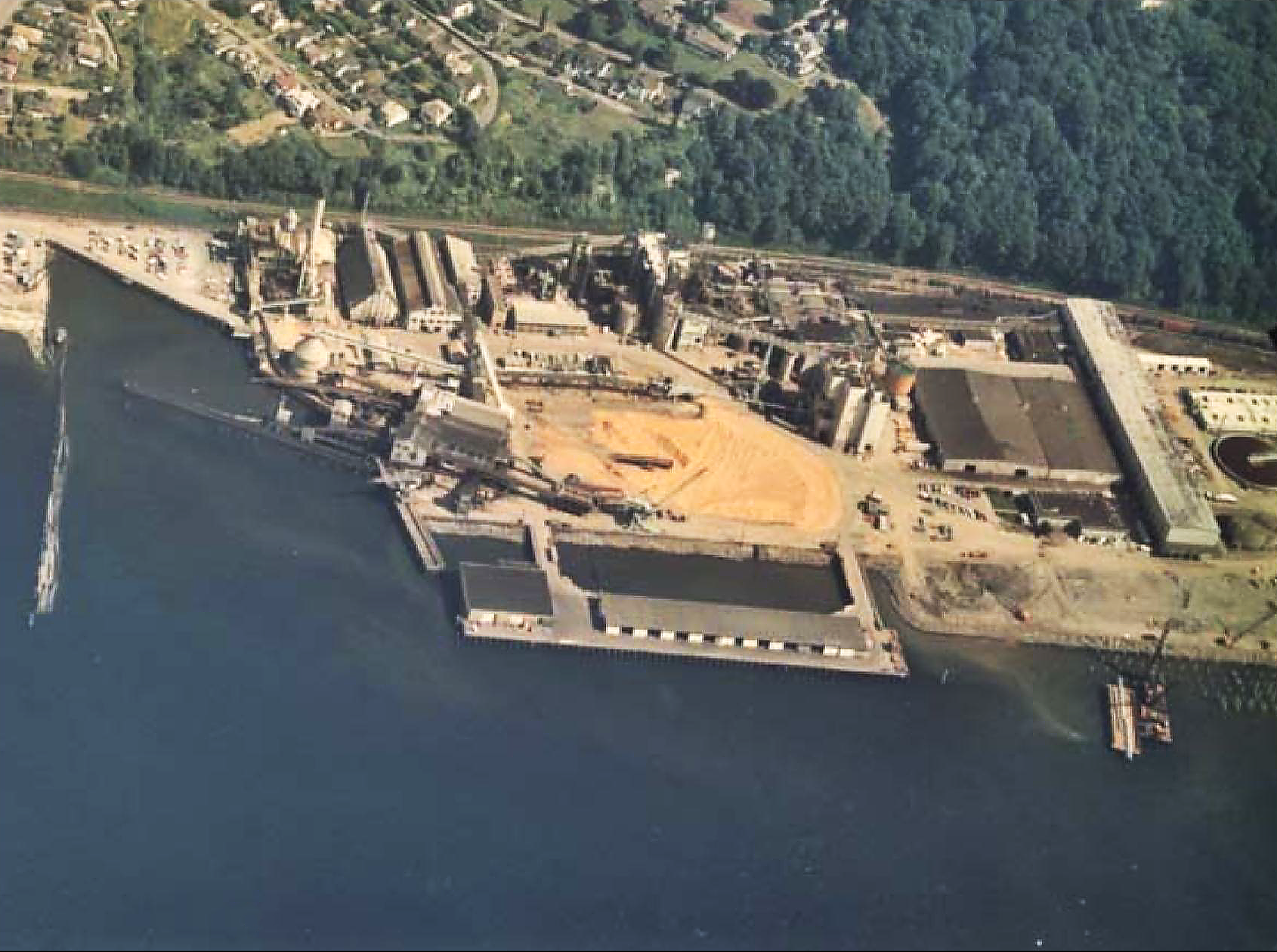 |
- "Weyerhaeuser Mills in Everett"
- "Port of Everett Breaks Ground on $36 Million South Terminal Wharf Modernization Project", 16 Aug 2018
Frederick Weyerhaeuser bought
Weyerhaeuser Mill B
Riverside Business Park, Everett
Weyerhaeuser opened a second mill on the river side of Everett in 1915. Like Mill A, it produced Douglas-fir lumber. Unlike the steam-powered Mill A, it was an all electric mill. The mill closed in 1979.
 |
Weyerhaeuser Mill C
Weyerhaeuser operated Mill C from 1923 to 1977. It was just to the northwest of Mill B on the opposite side of what is today SR 529. It processed hemlock and cedar.
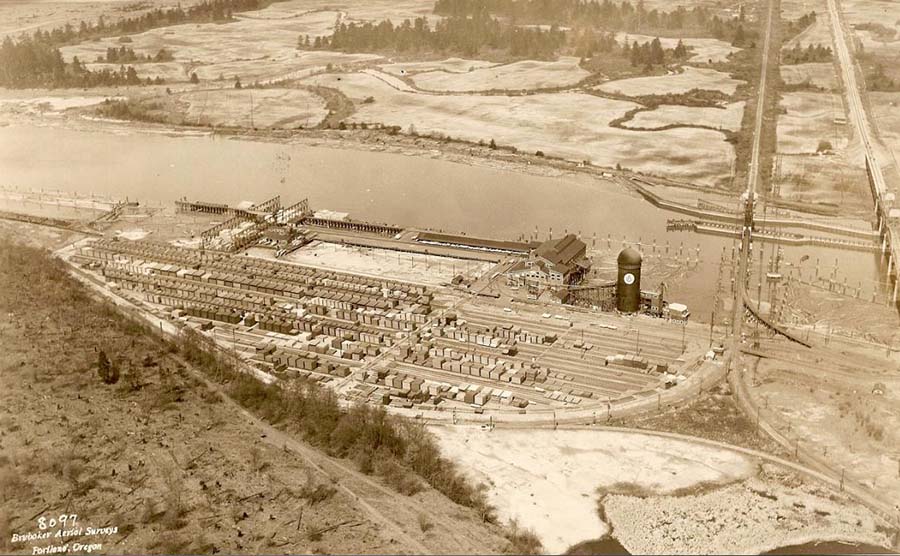 |
Homes
14514 57th Ave W
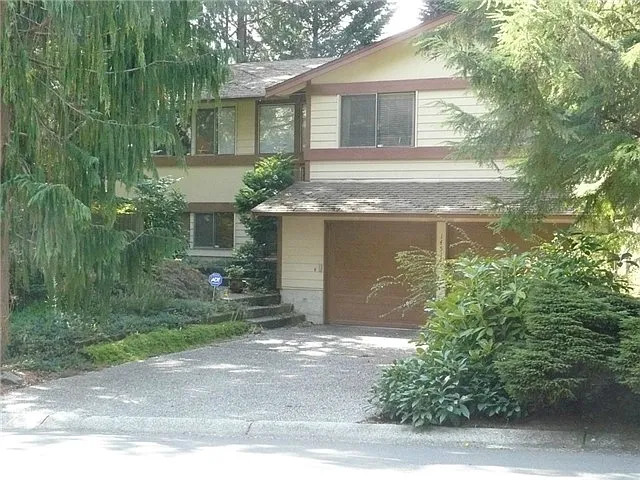 |
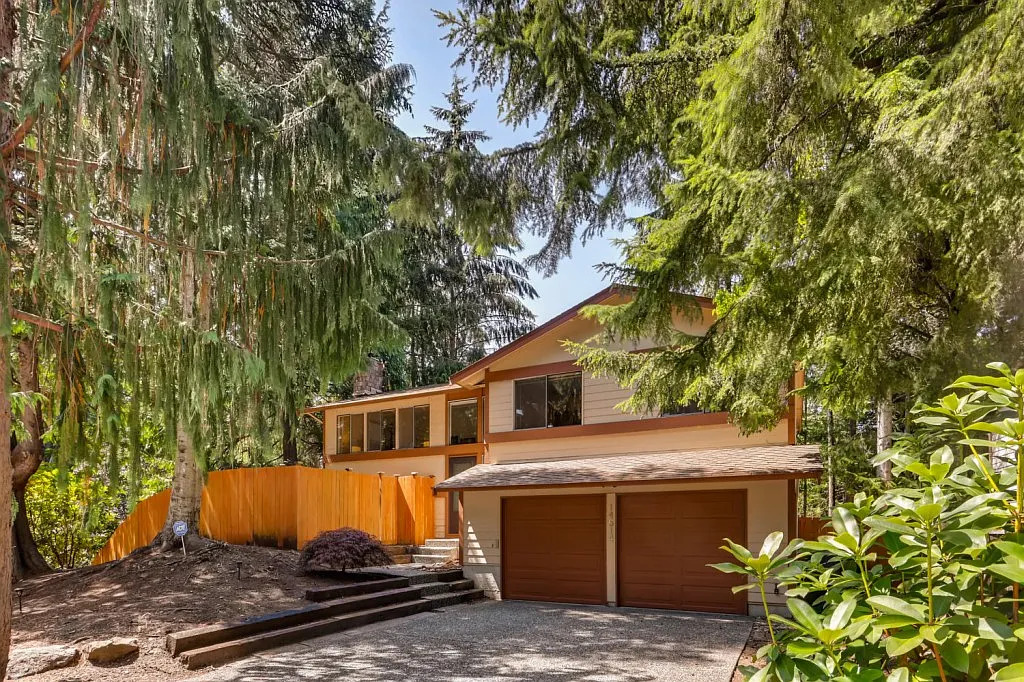 |
My parents bought this house when it was new in 1976 for $44,000. It was originally stained gray with a darker gray for trim. My Mom sold it in 1982 or 1983 and it sold again in 2019 for $520,000. My parents planted the Weeping Alaskan Cedar on the left. It was only a few feet tall when it went in. Dad borrowed grandpa's Ford truck to get those railroad ties, which were purchased down in Kent.
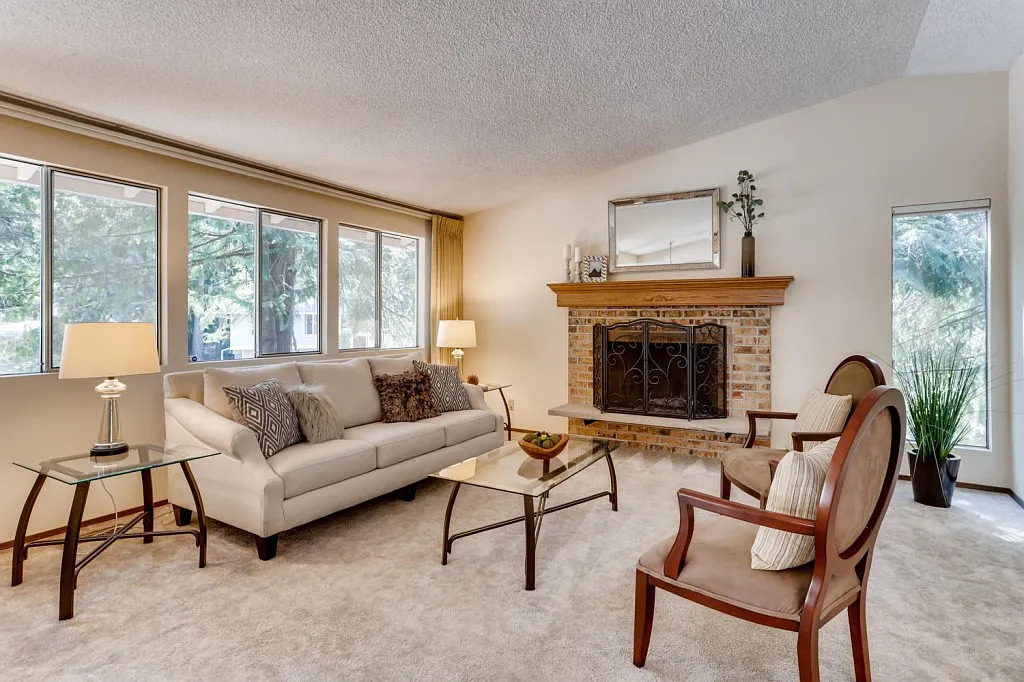 |
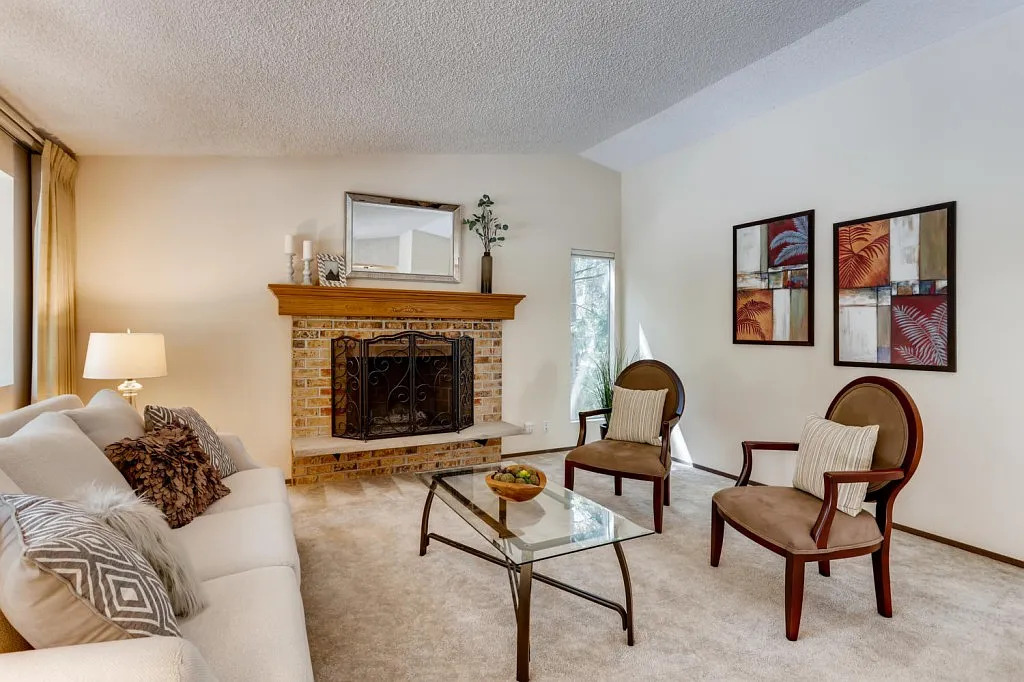 |
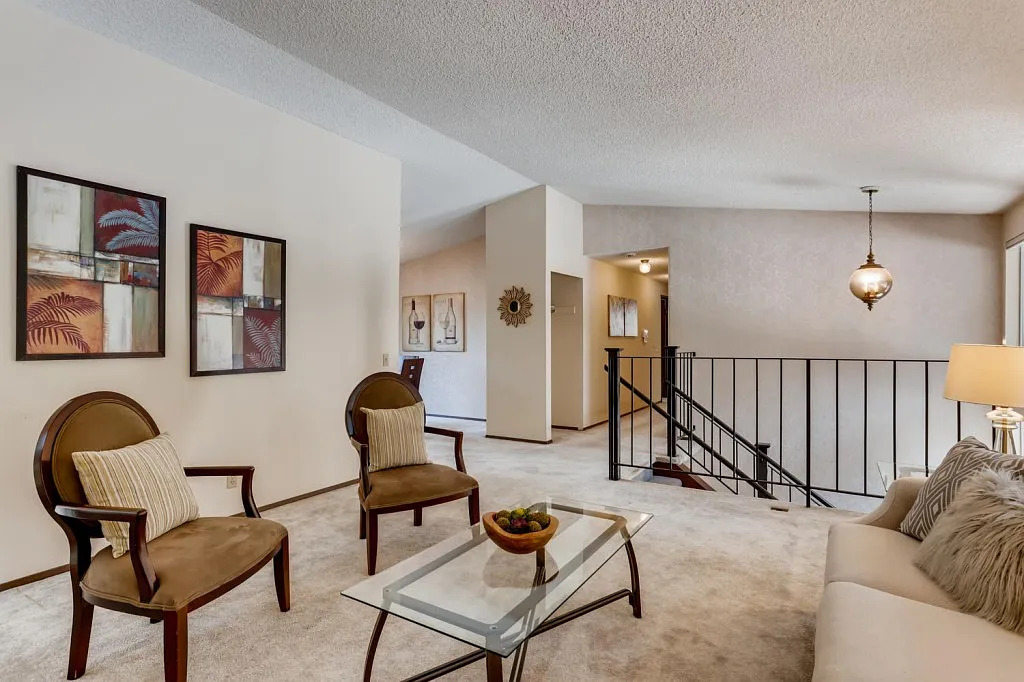 |
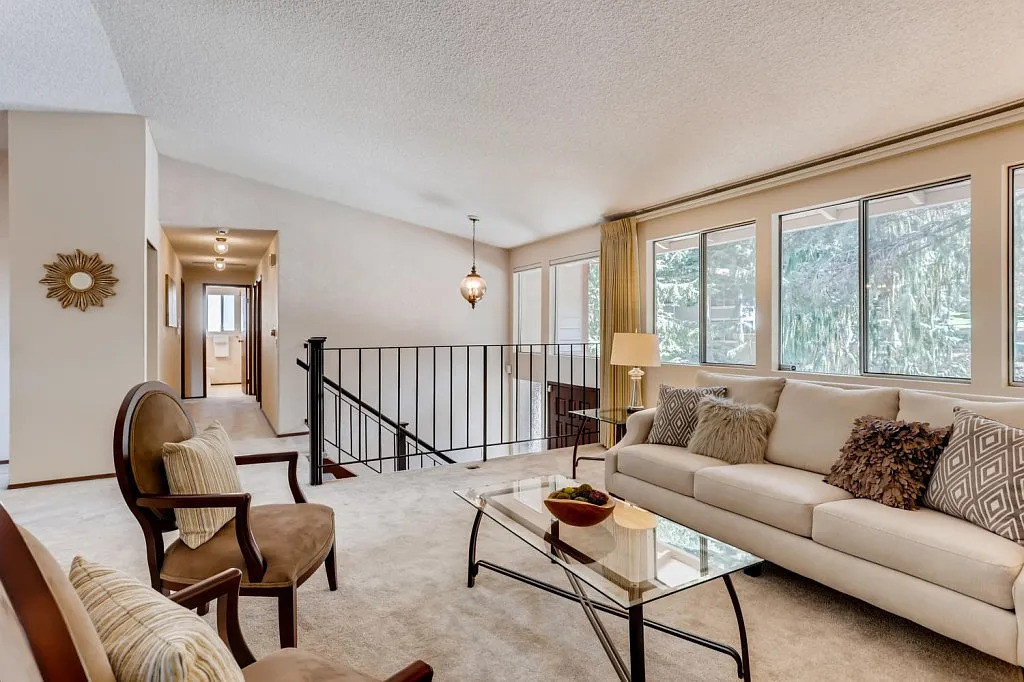 |
The original carpet was a yellow shag. I don't remember the popcorn ceiling but it must be original. My parents kept a parlor grand in the living room.
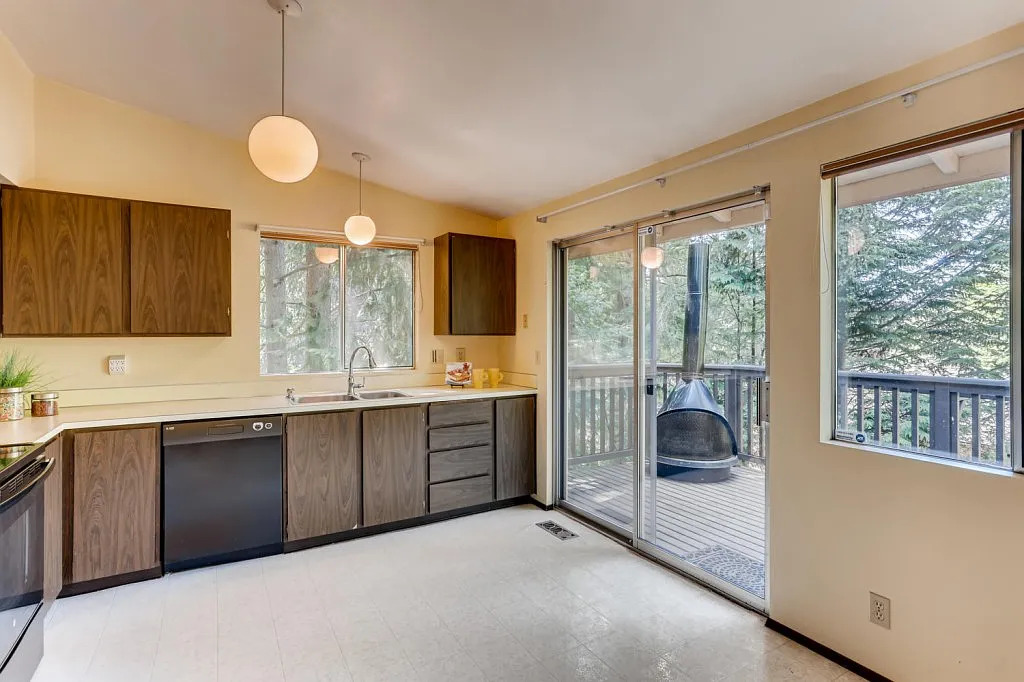 |
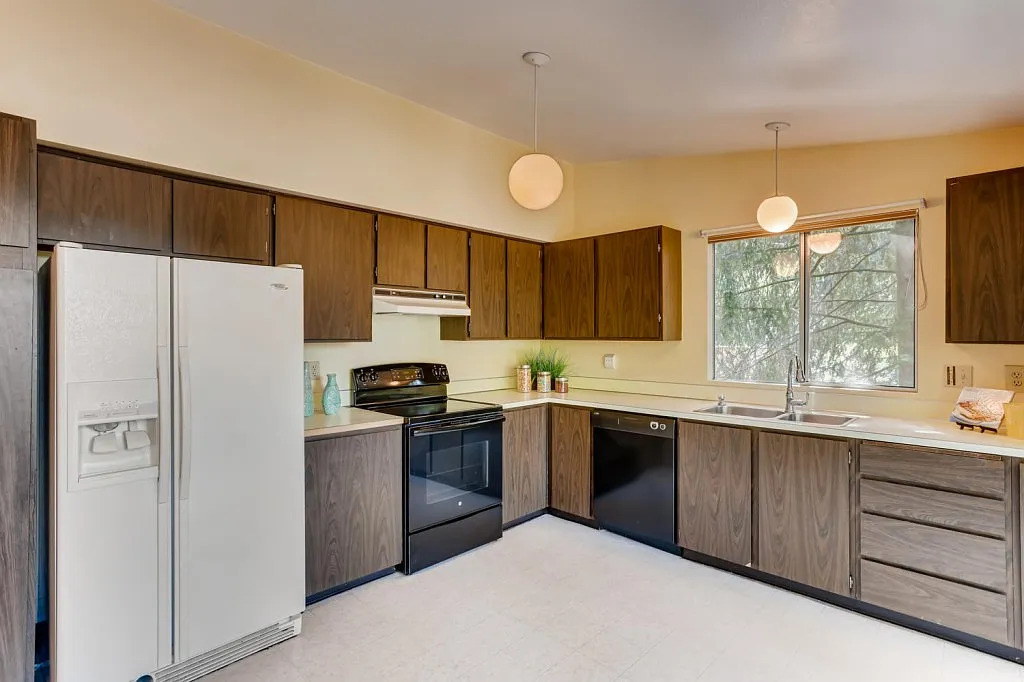 |
 |
 |
The cabinets and the counters in the kitchen are original. There was room for a table in the kitchen, but it made the kitchen too crowded in retrospect. When we moved in, it was possible to see the Olympics from the dining room—trees obscure the mountains now.
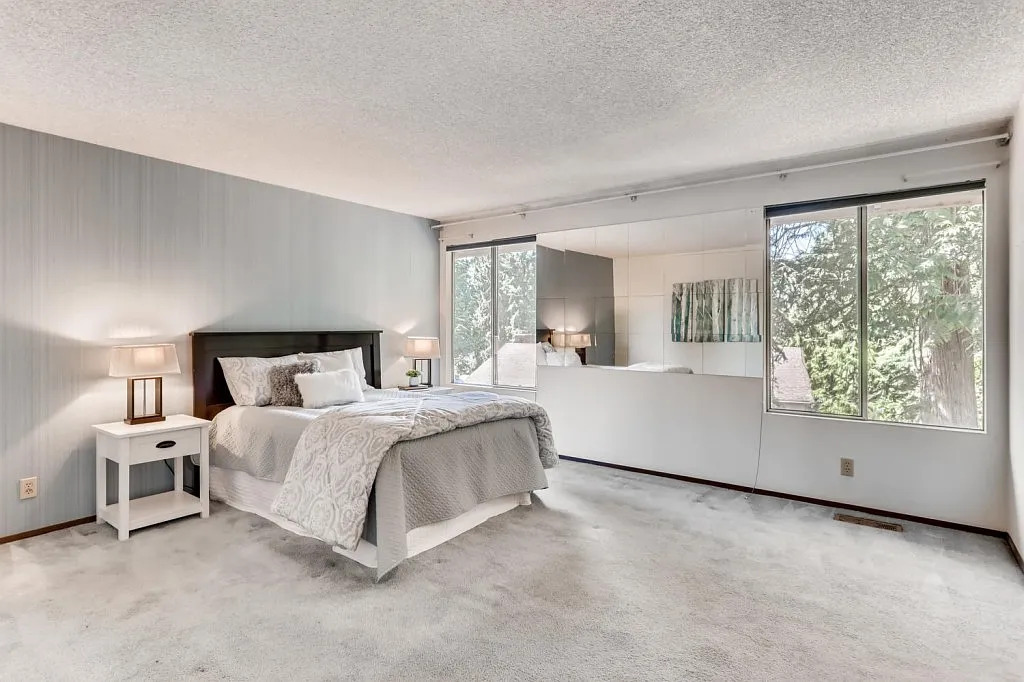 |
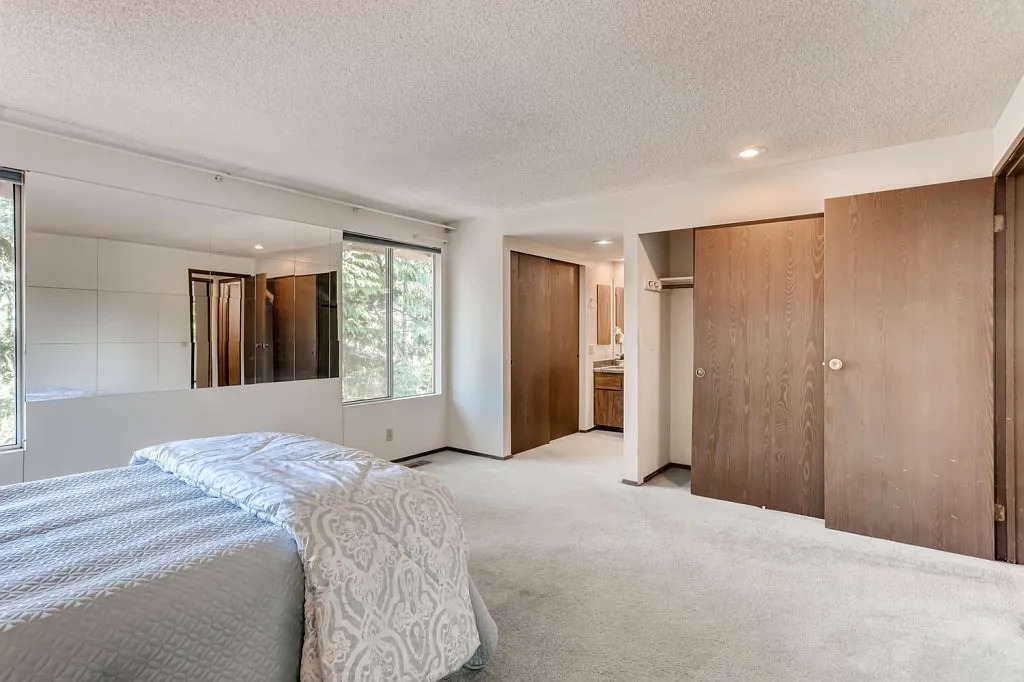 |
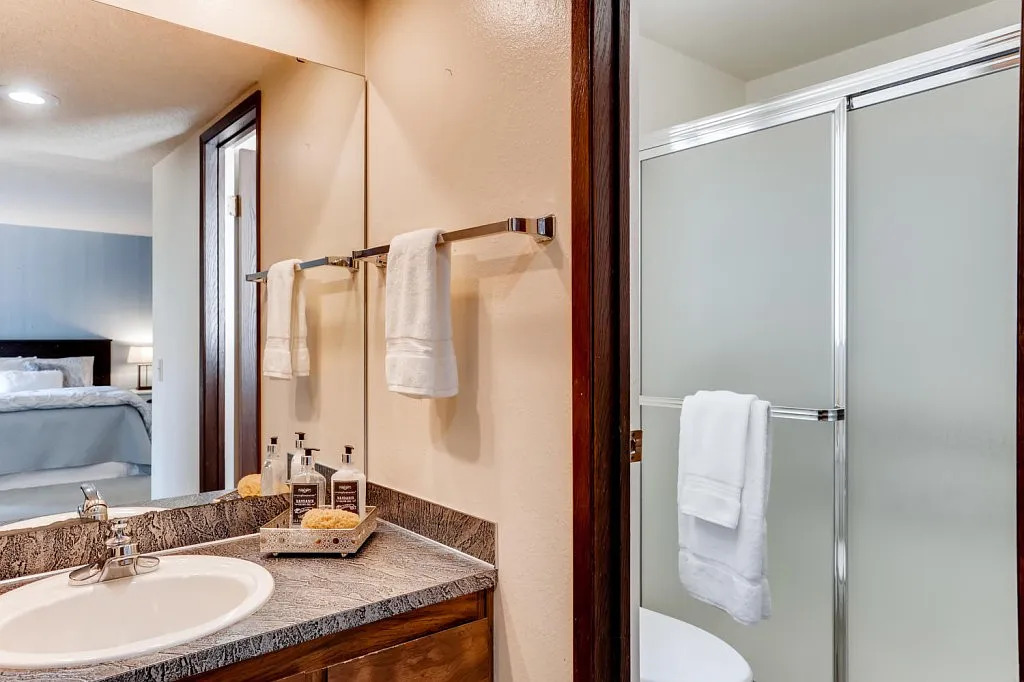 |
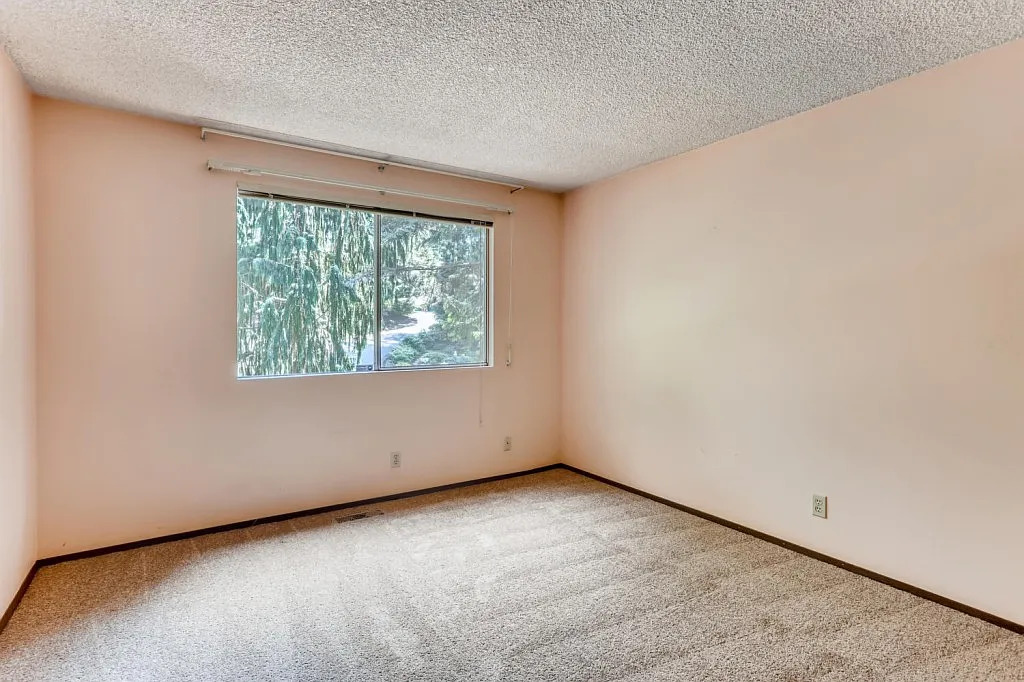 |
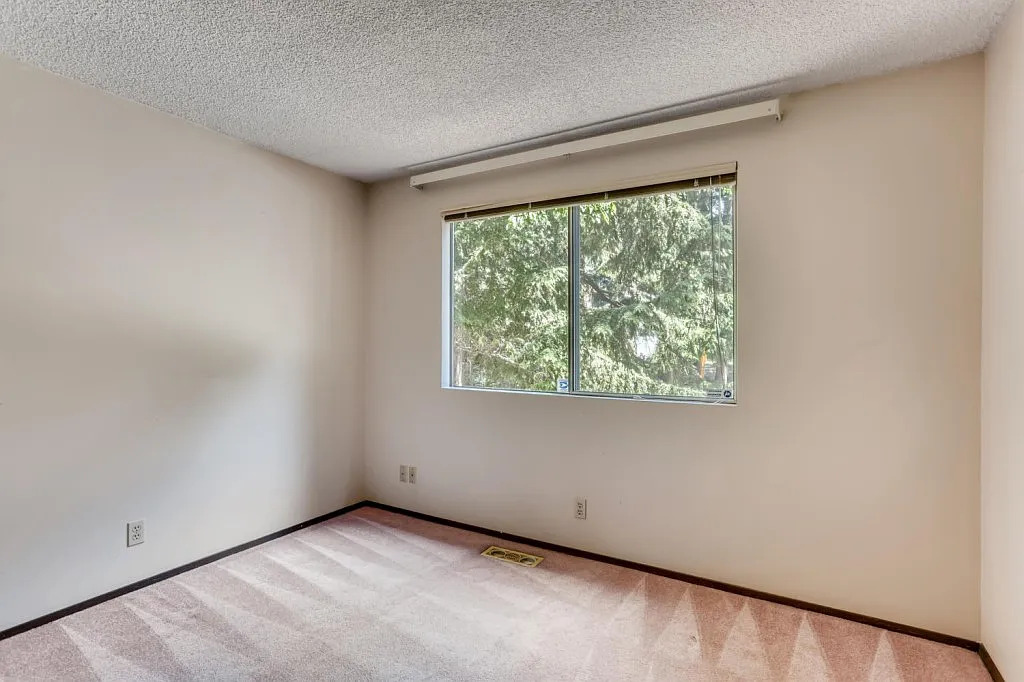 |
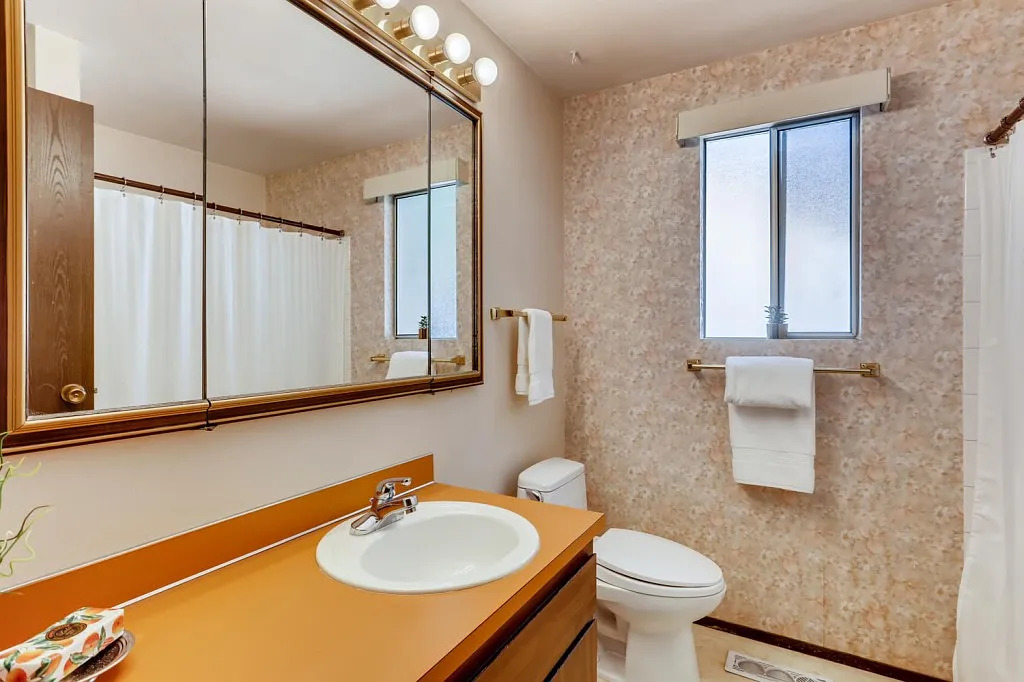 |
I think my parents installed the mirrors between the windows in the master bedroom, and I believe the counters and cabinets in the bathrooms are original. I remember the orange formica pretty clearly.
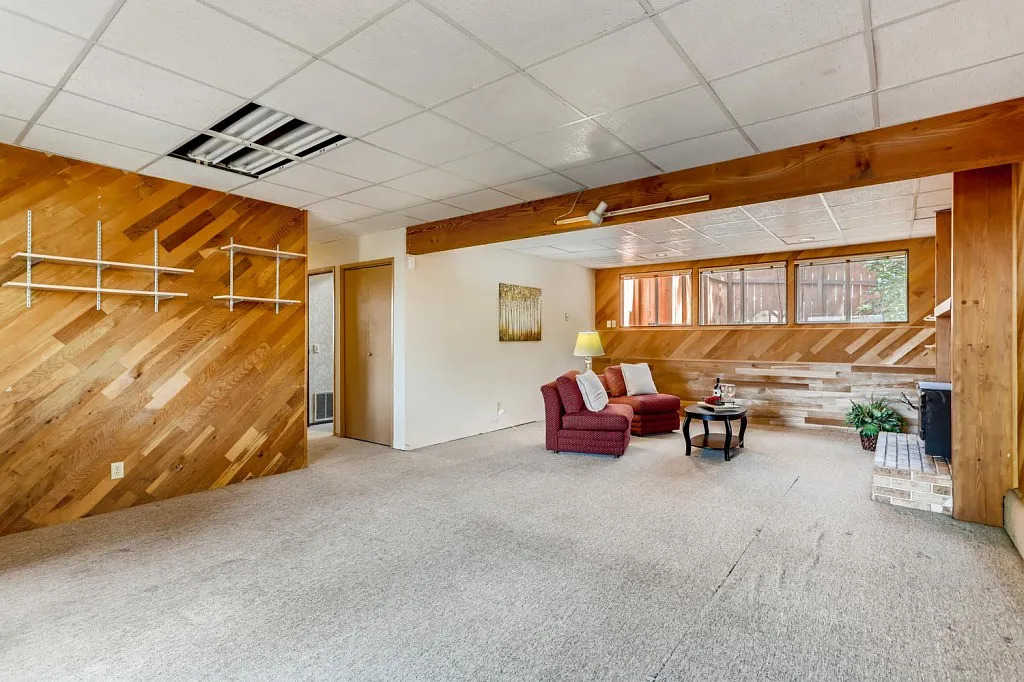 |
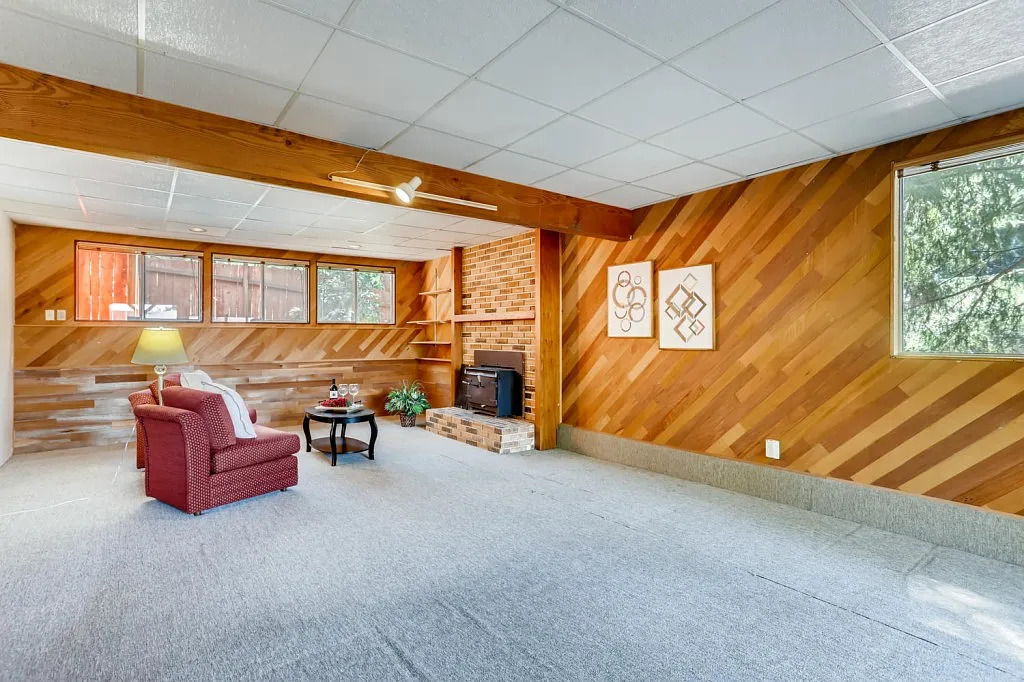 |
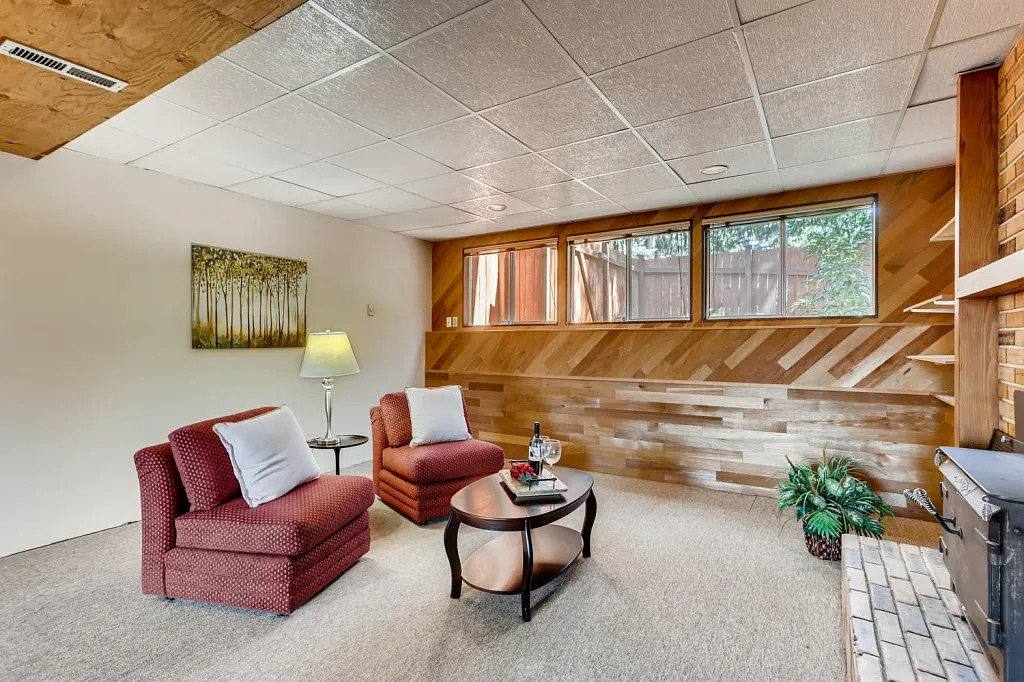 |
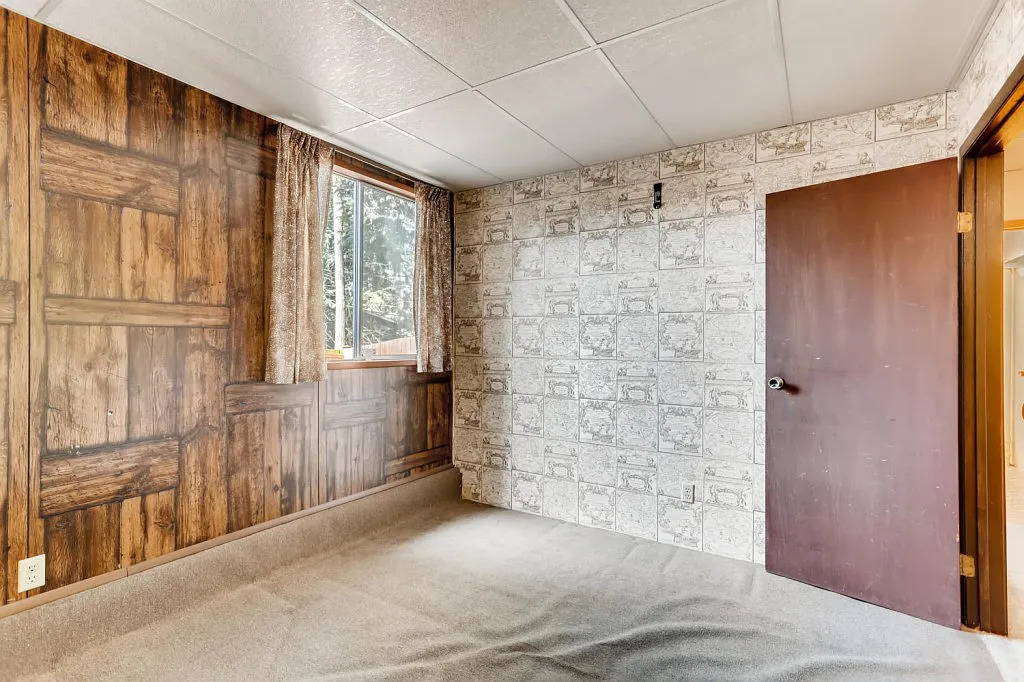 |
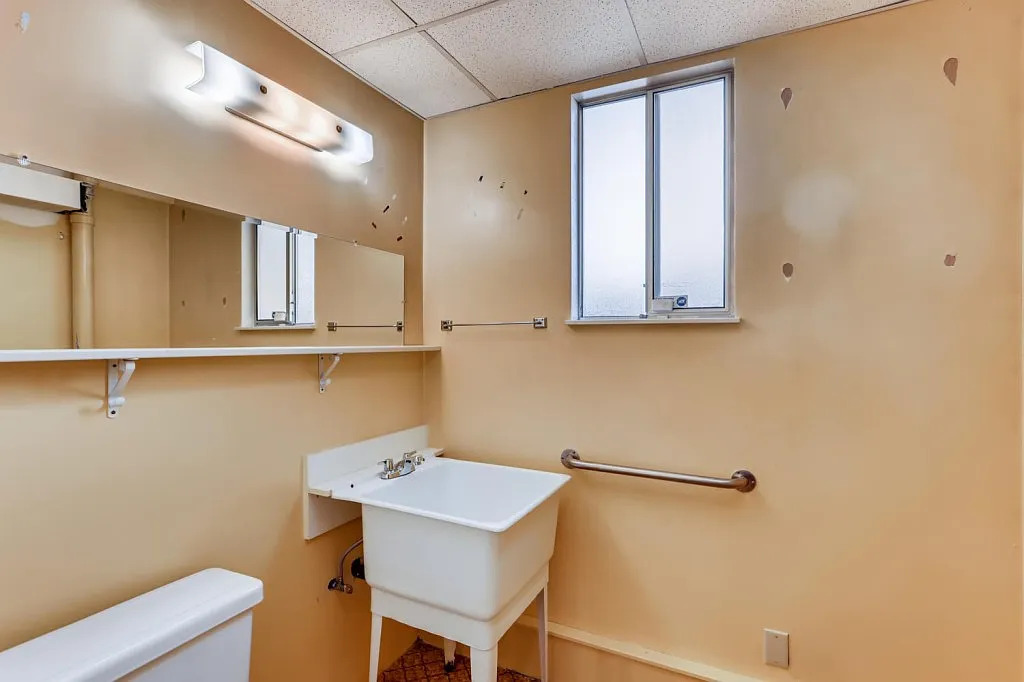 |
The downstairs was unfinished when we moved in in 1976. My dad put in the walls and installed drywall. We had a blue parakeet named Freddie who flew up to the top of one of the walls before the ceiling was installed and fell inside the wall. I was horrified but dad cut a hole in the drywall and saved him.
The diagonal wood siding and wood stove were put in by my parents. They also got this old wooden bench from a building that was being remodeled and installed it under the three windows as a piece of built-in furniture. It didn't look right and they never finished the project off, so small surprise it isn't there.
The bedroom downstairs was built for me. I may have chosen the wallpaper with the age-of-exploration maps myself. The curtains and even the carpet look like what I had. Out-of-picture to the left there was a built-in dresser with corkboard over it, and left of that a closet with sliding doors.
 |
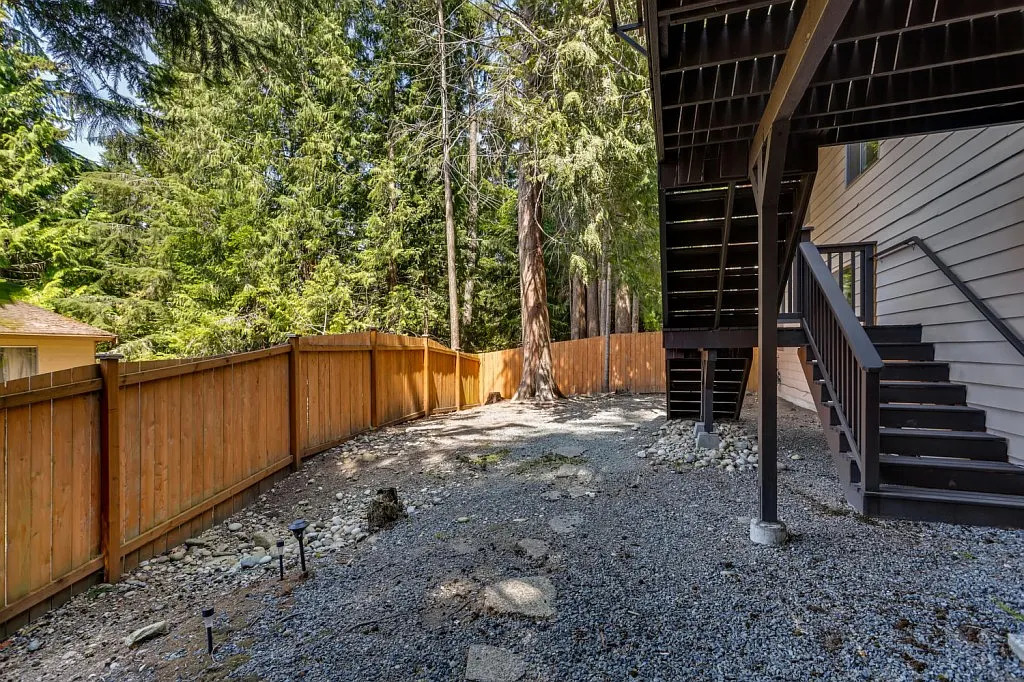 |
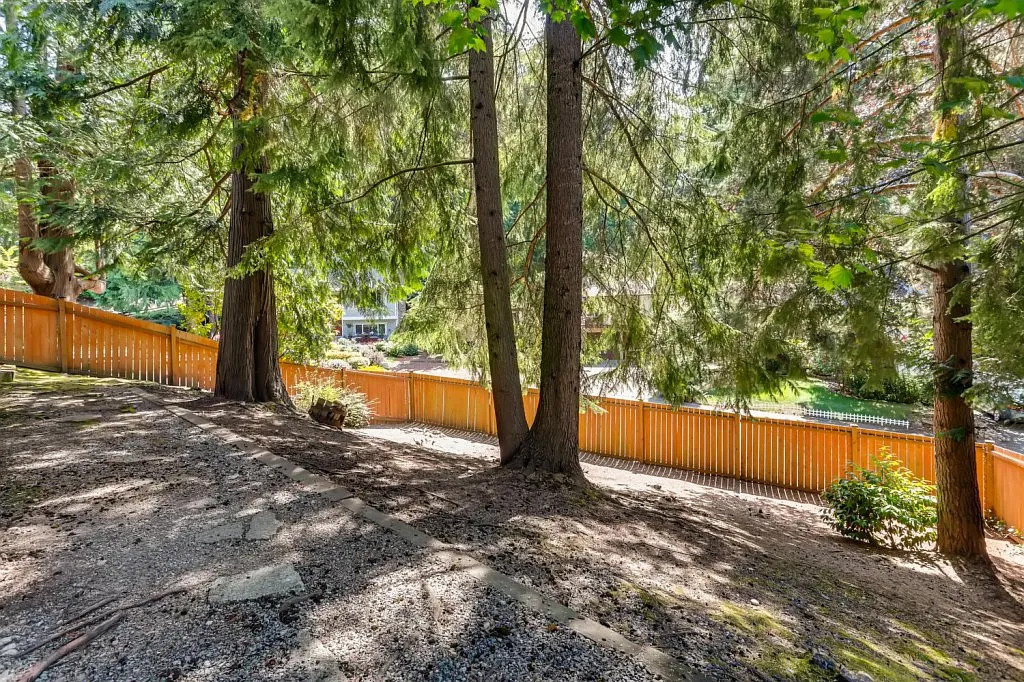 |
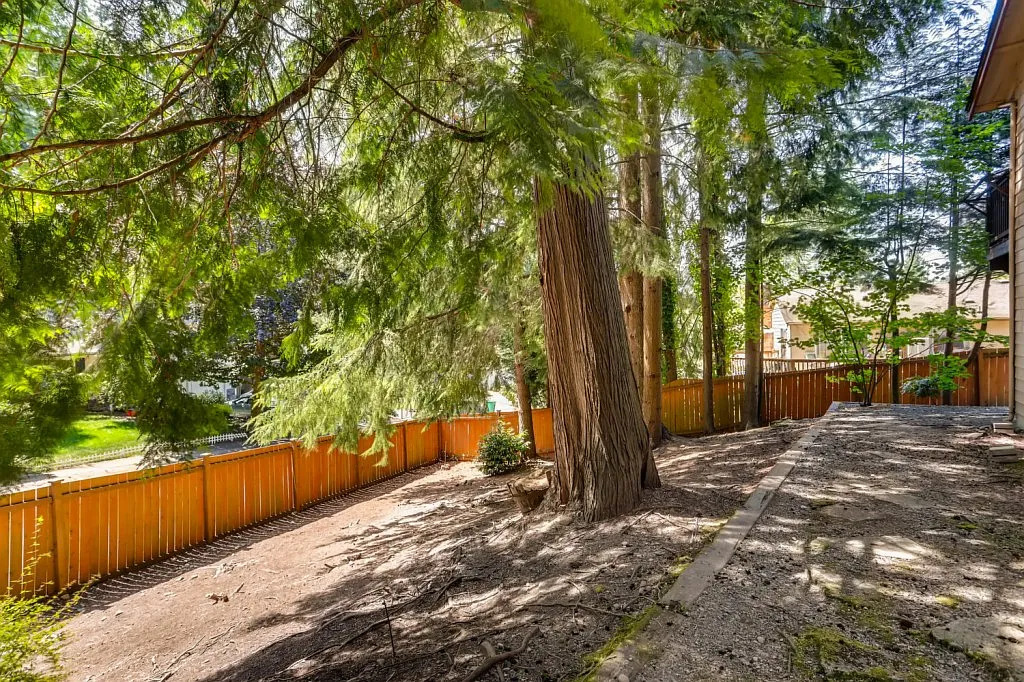 |
The back deck was replaced. The old deck had a simple flight of stairs. No landing halfway down with a choice of way to go. My parents never put up a fence. The fourth picture shows some Western Hemlocks behind a Western Red Cedar. The hemlocks were human height when I was a kid. My parents had lawn in front and I think we got some patchy grass to grow in back. The side yard in the fourth picture had bark and junipers, but it looked much better in 2019. I like how the ground is mostly bare. Simple, natural, and low maintenance.
